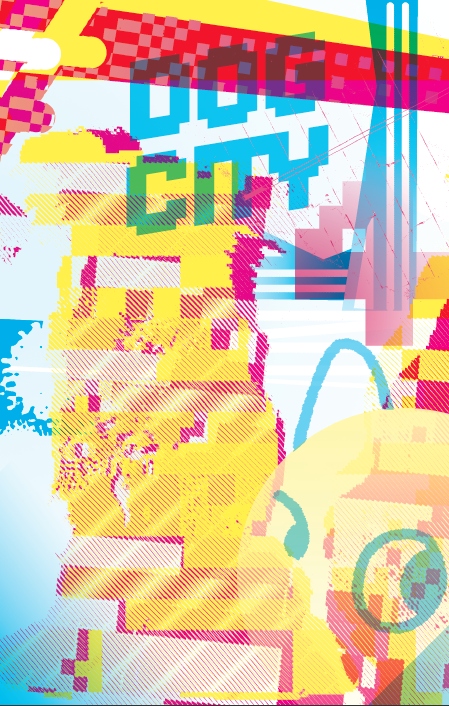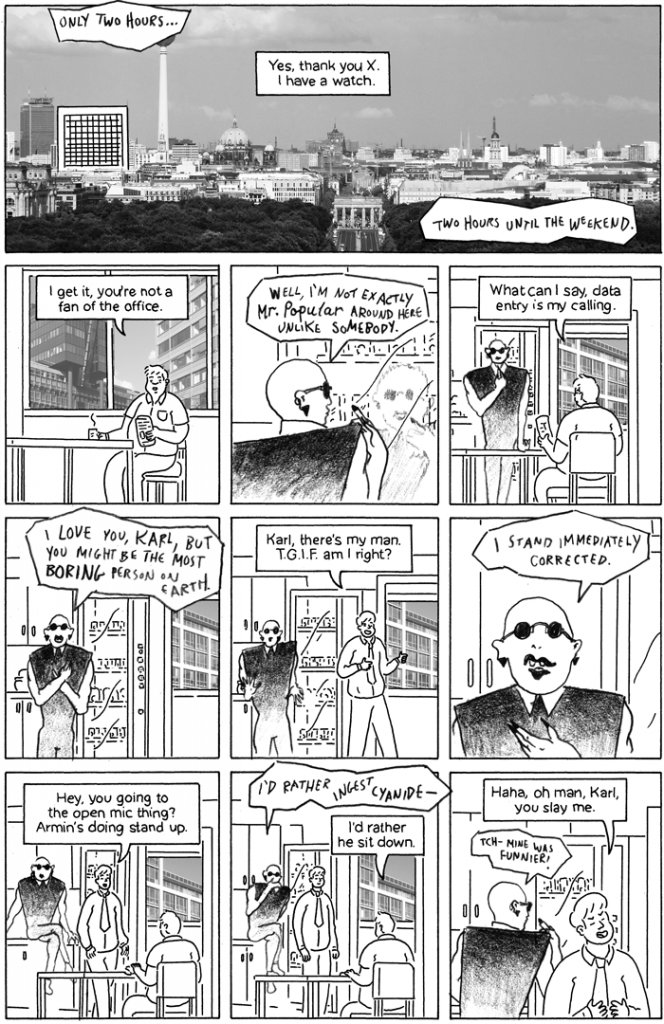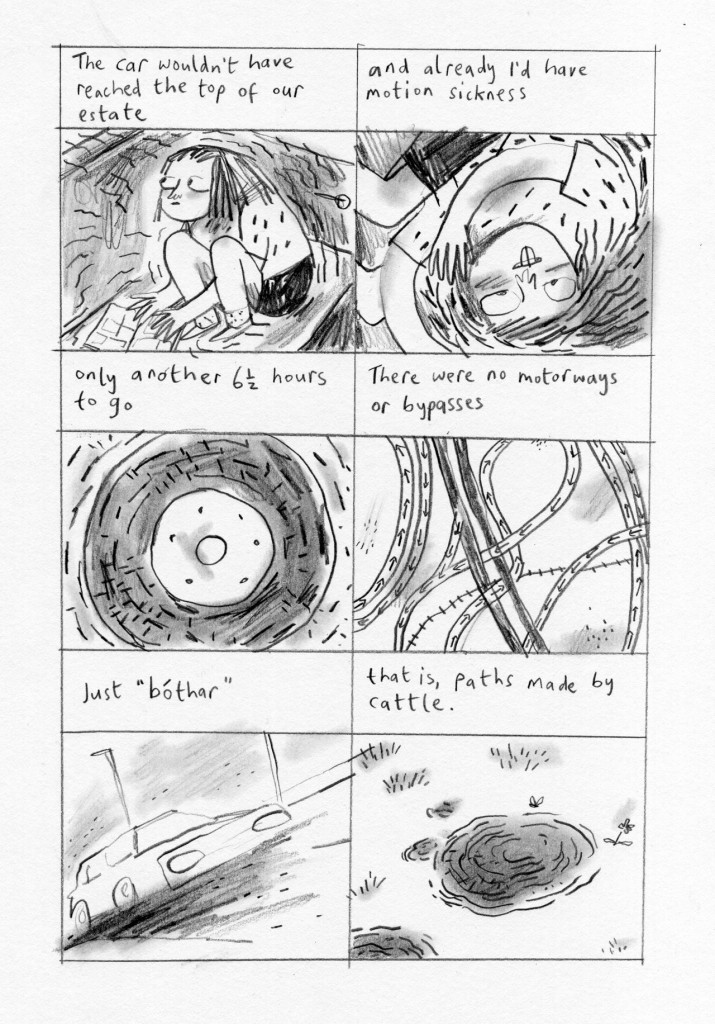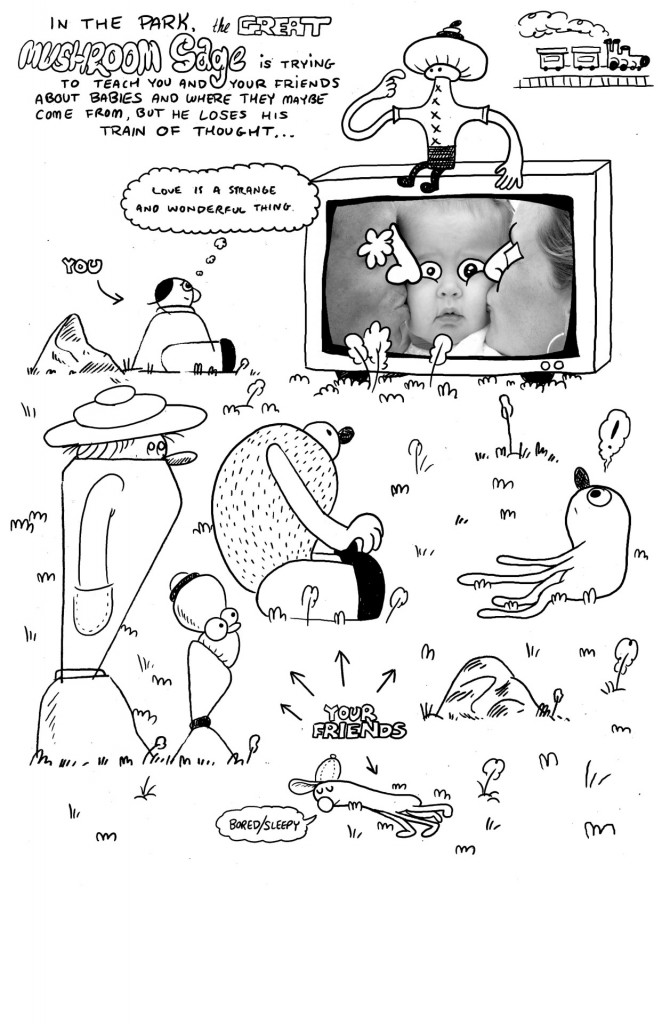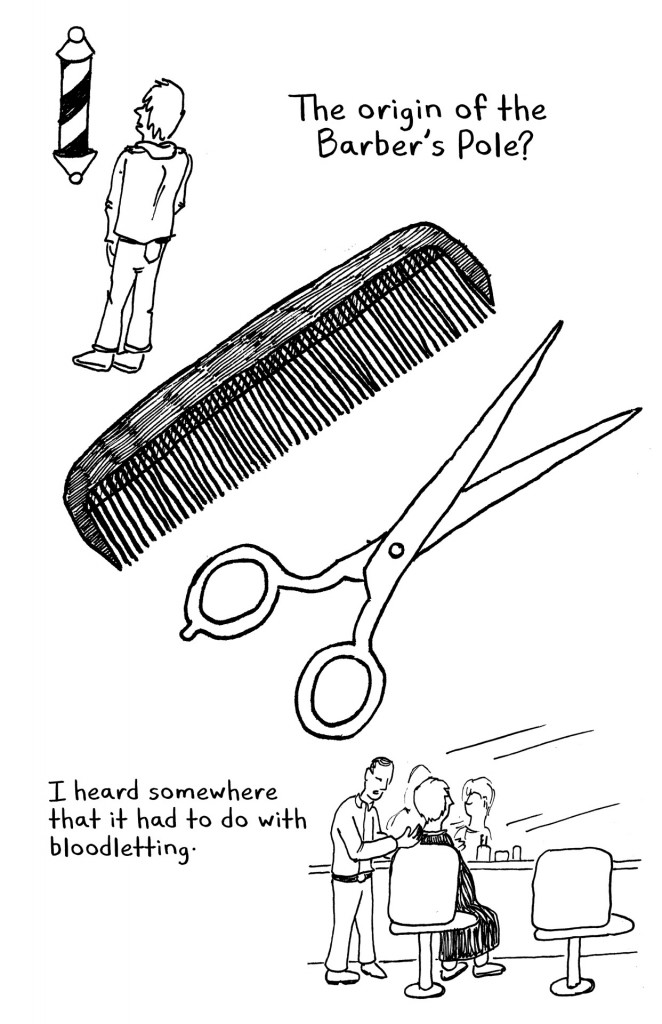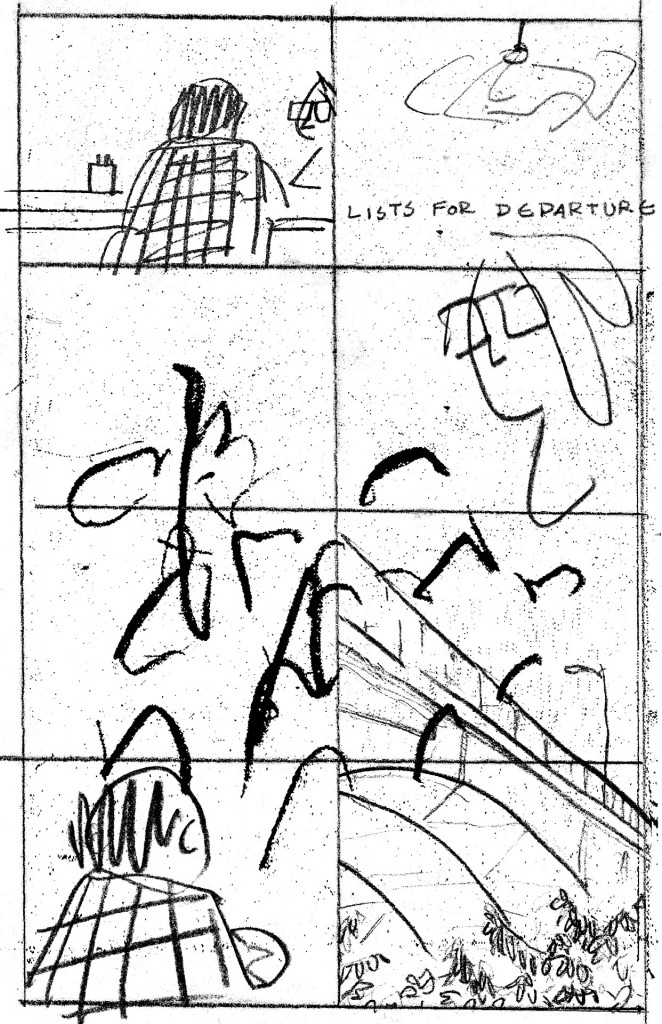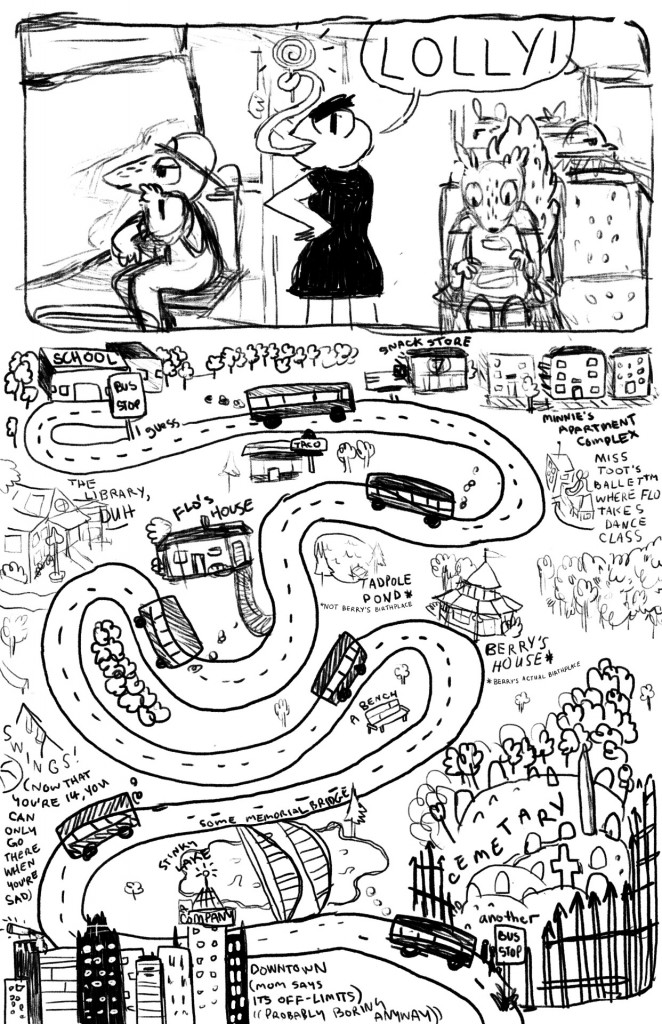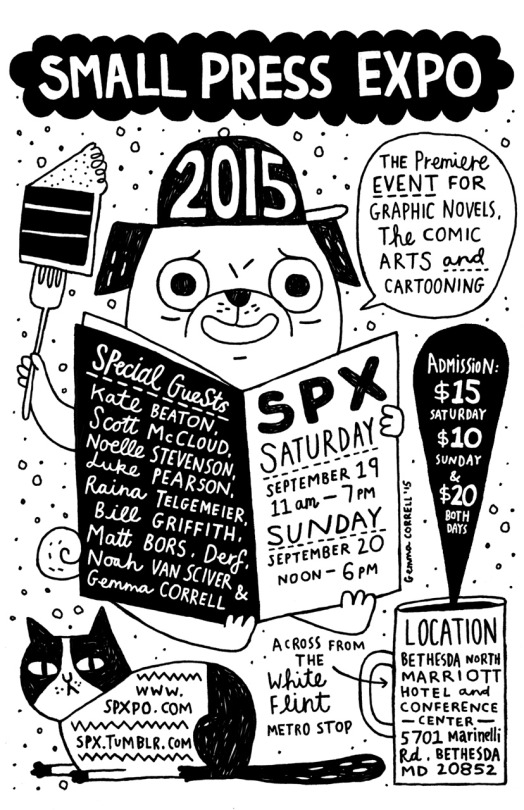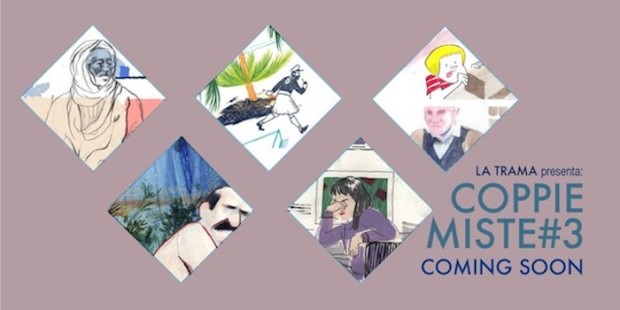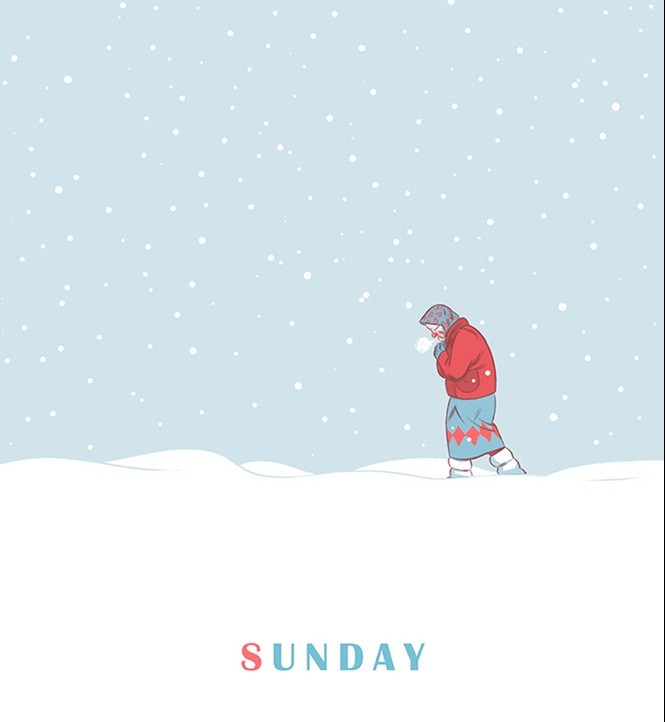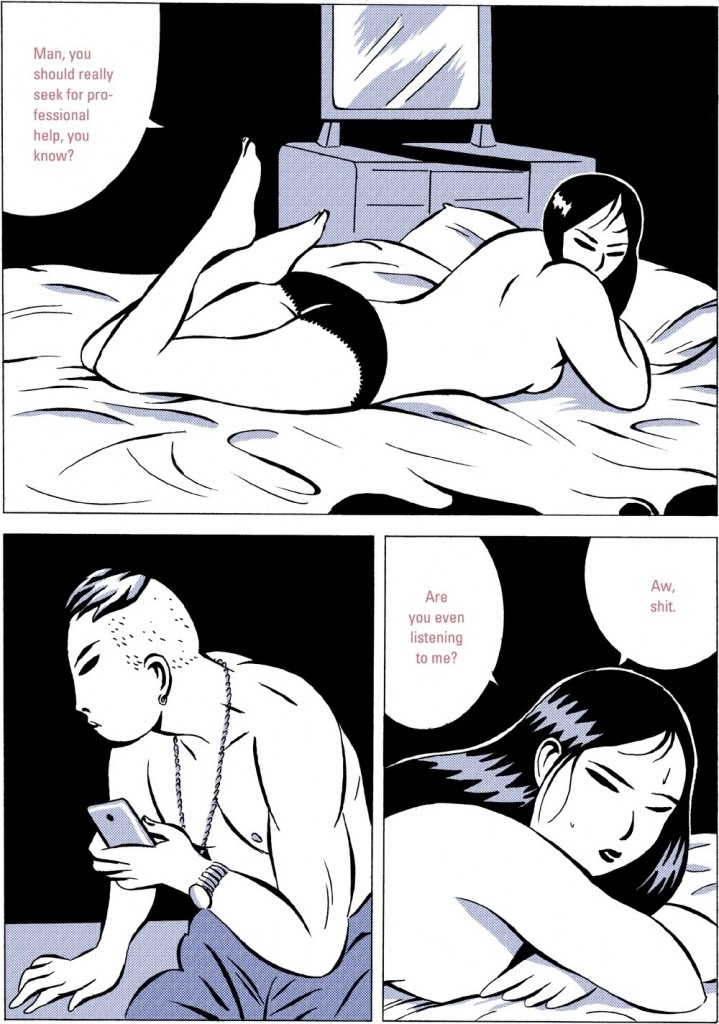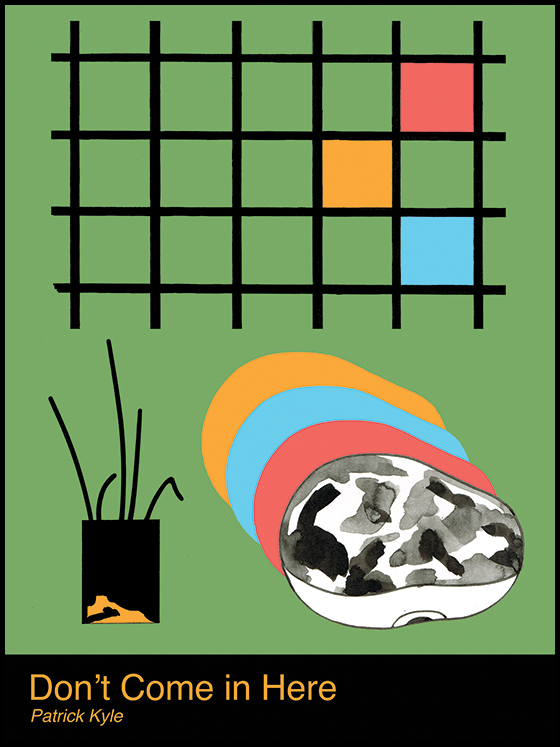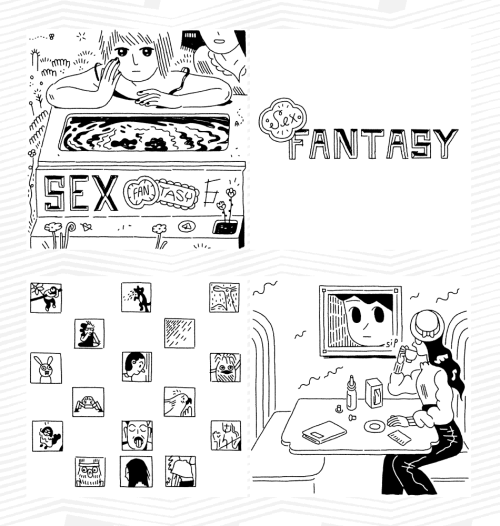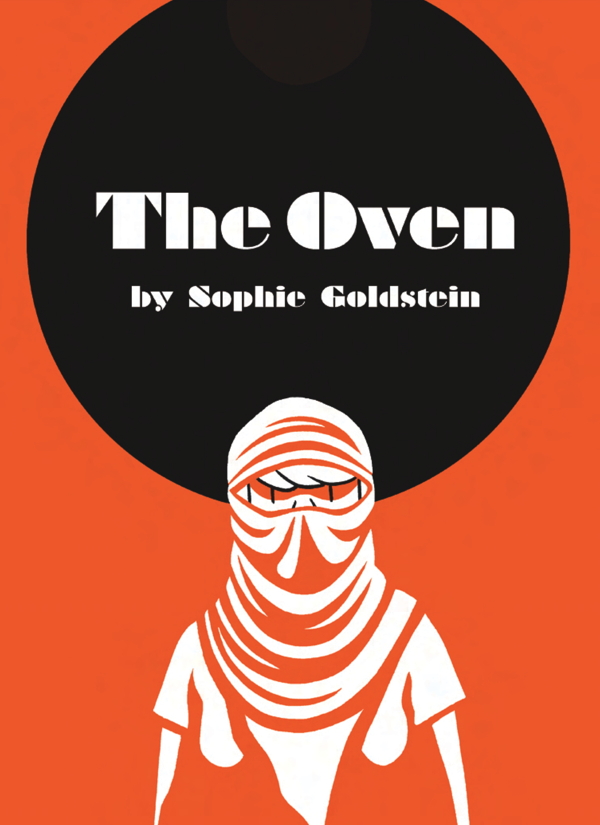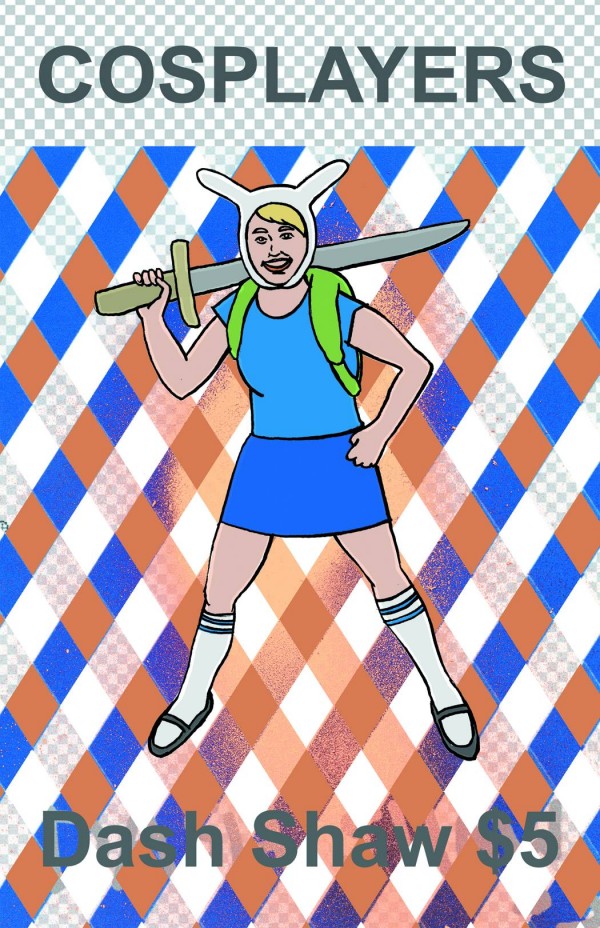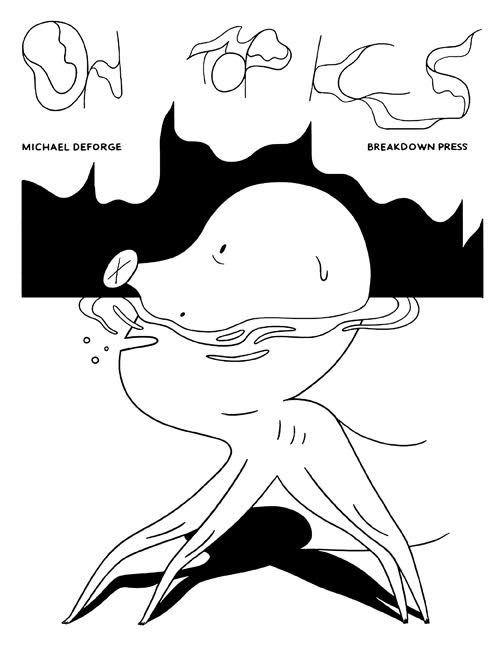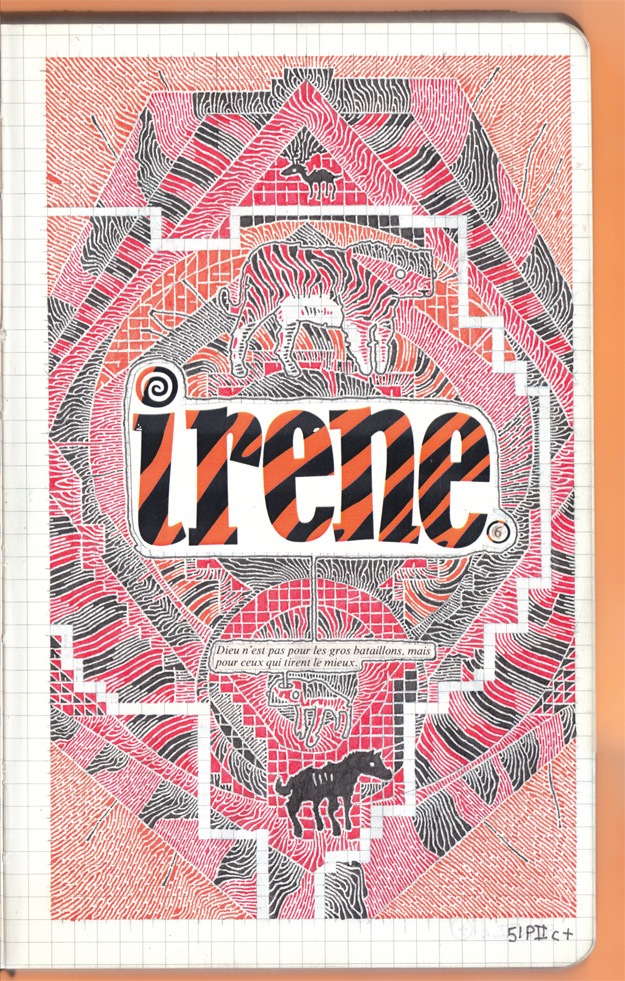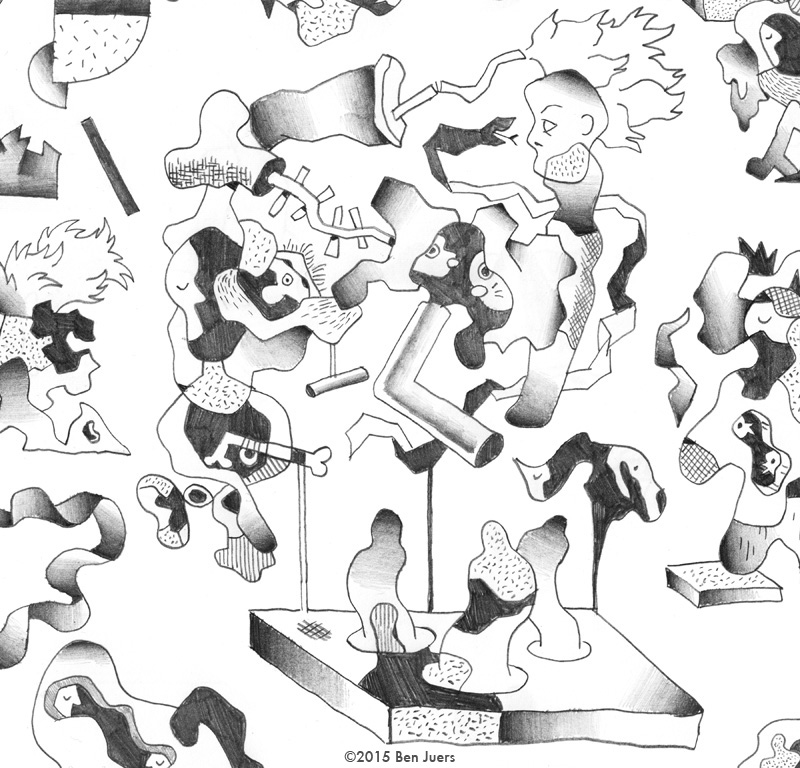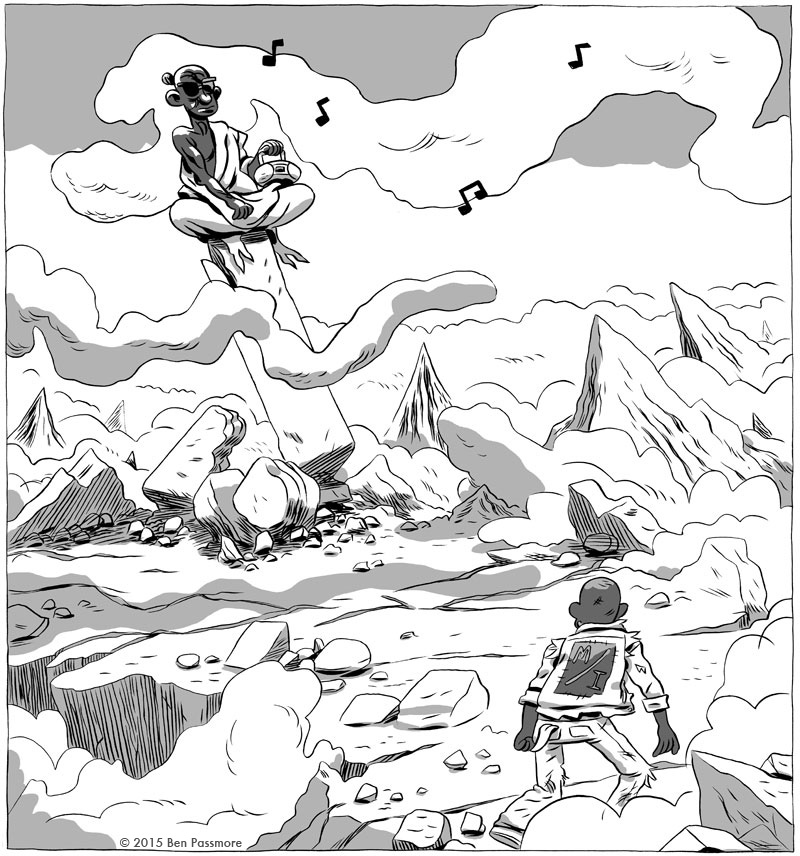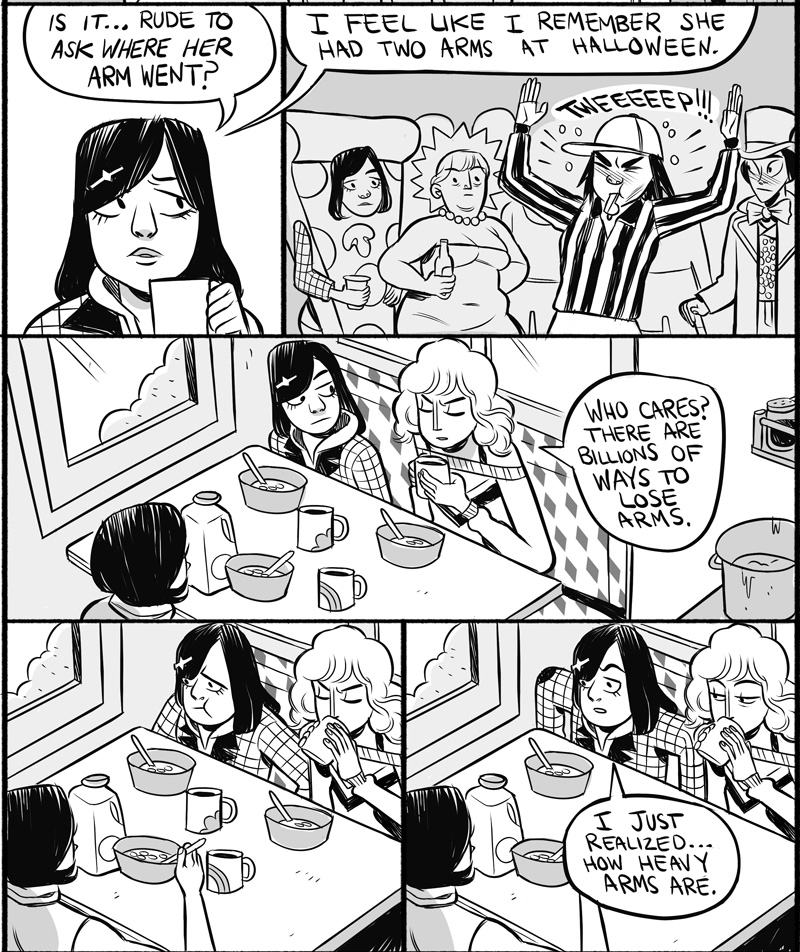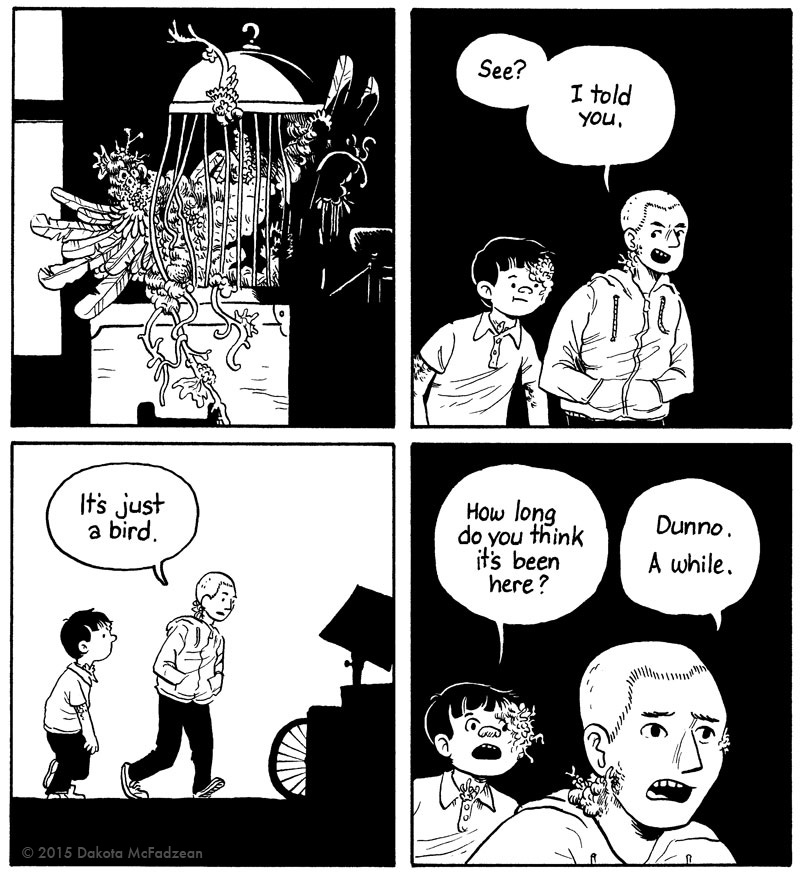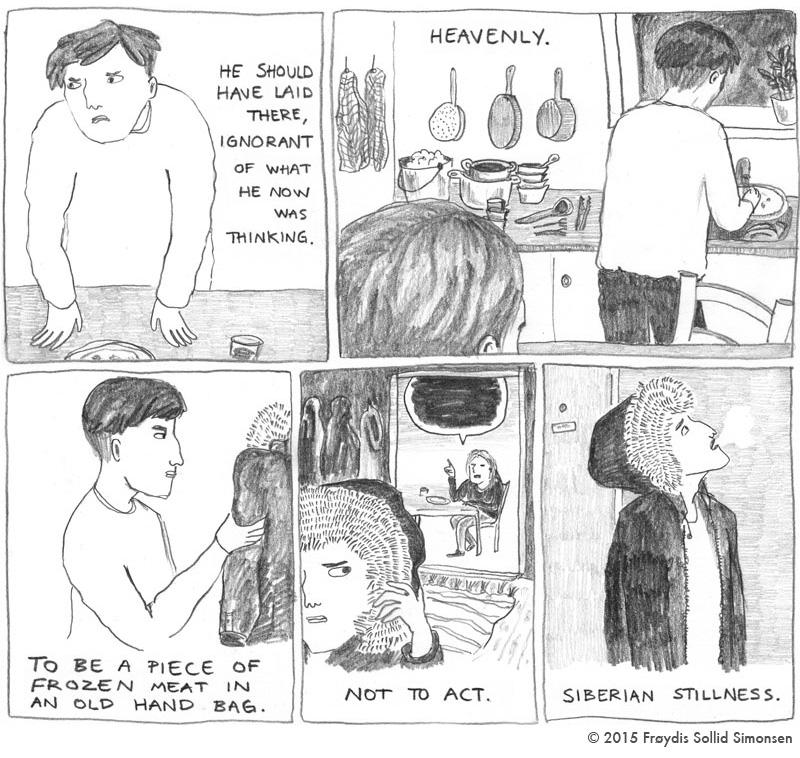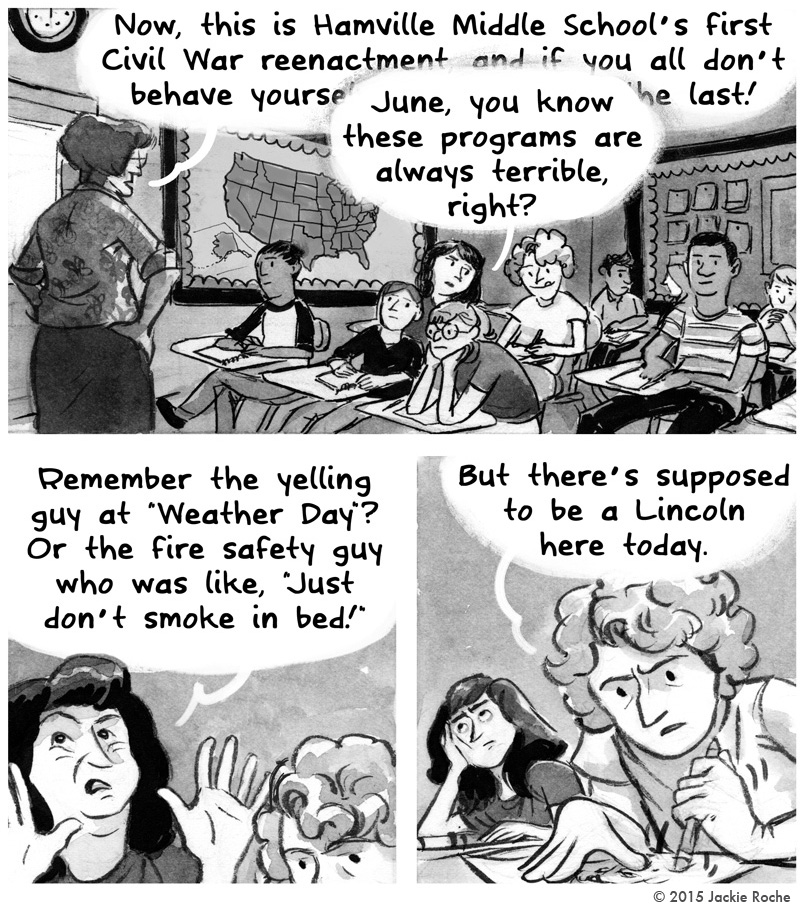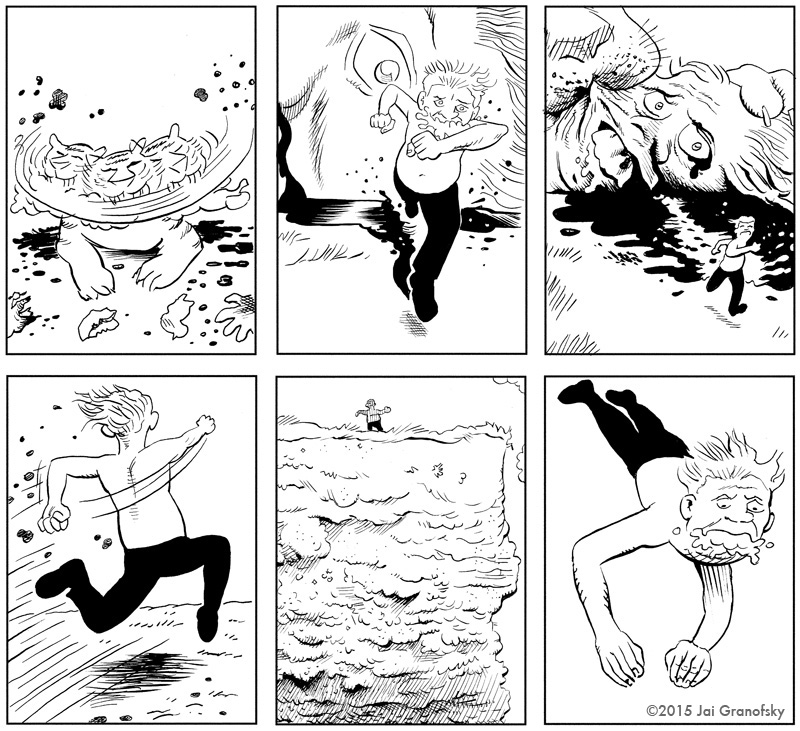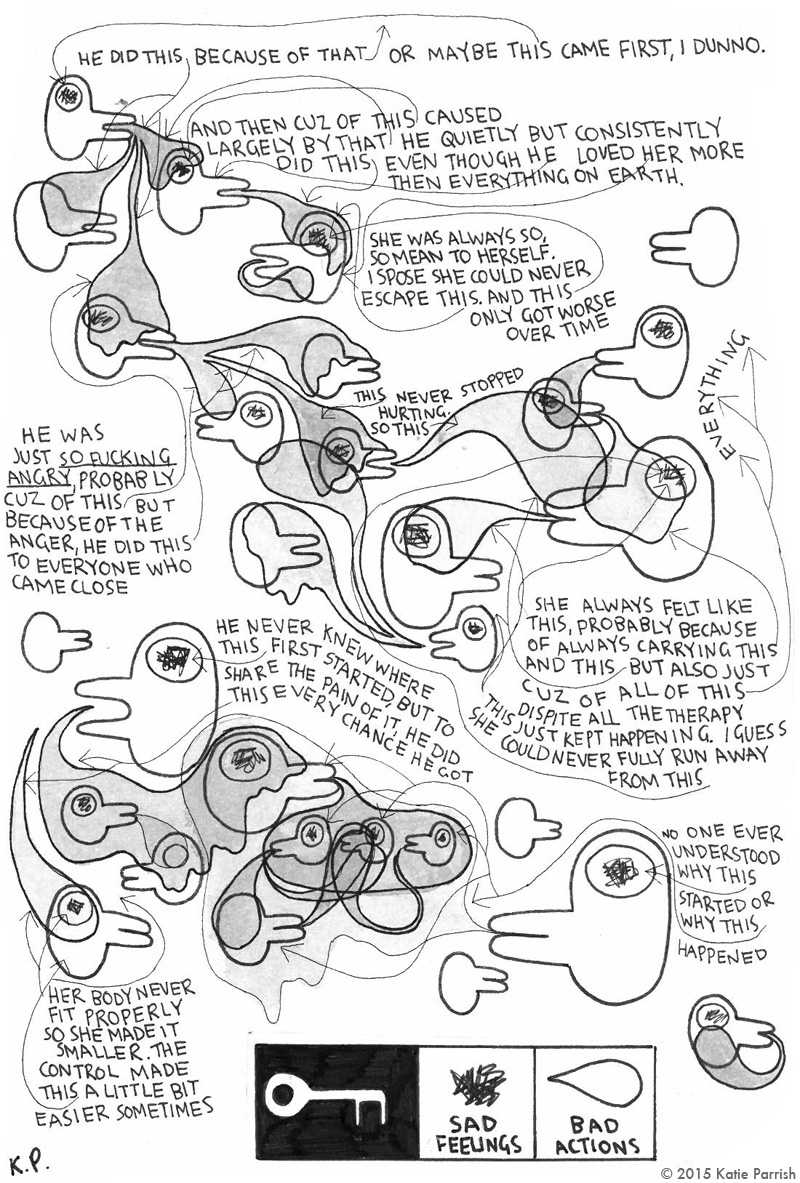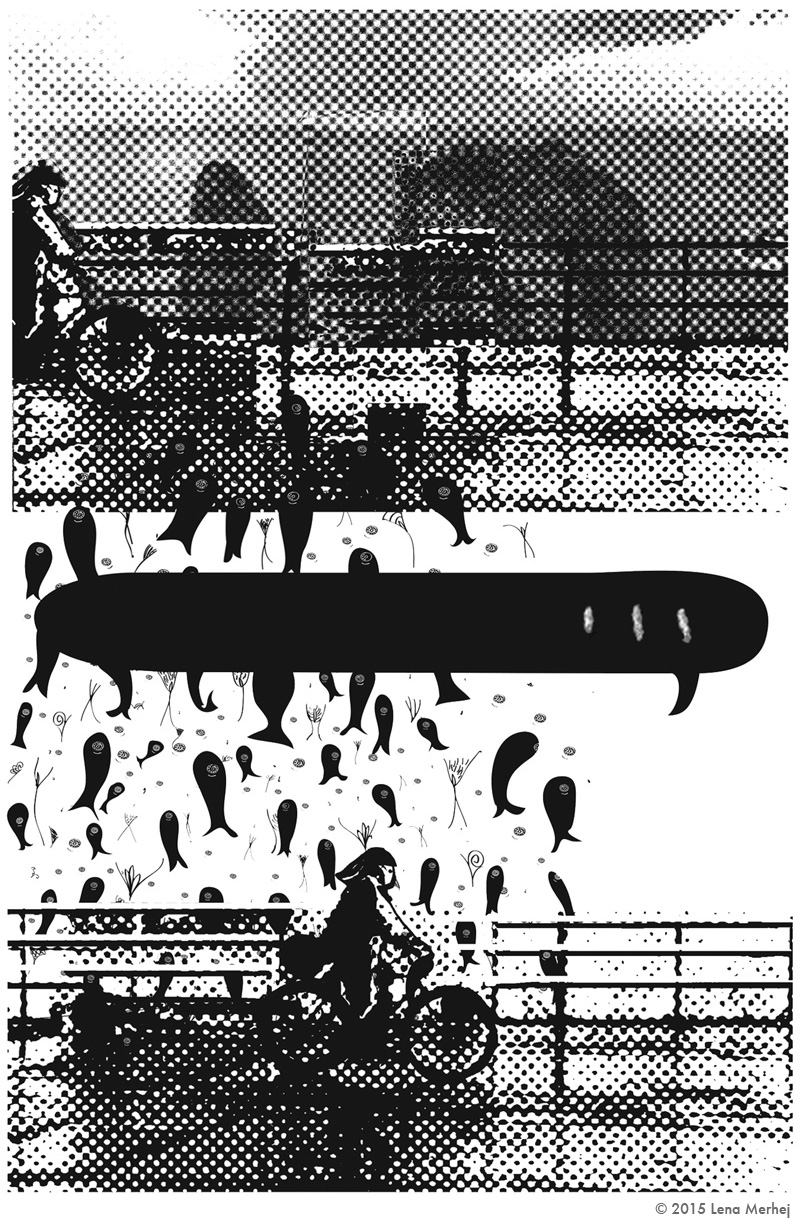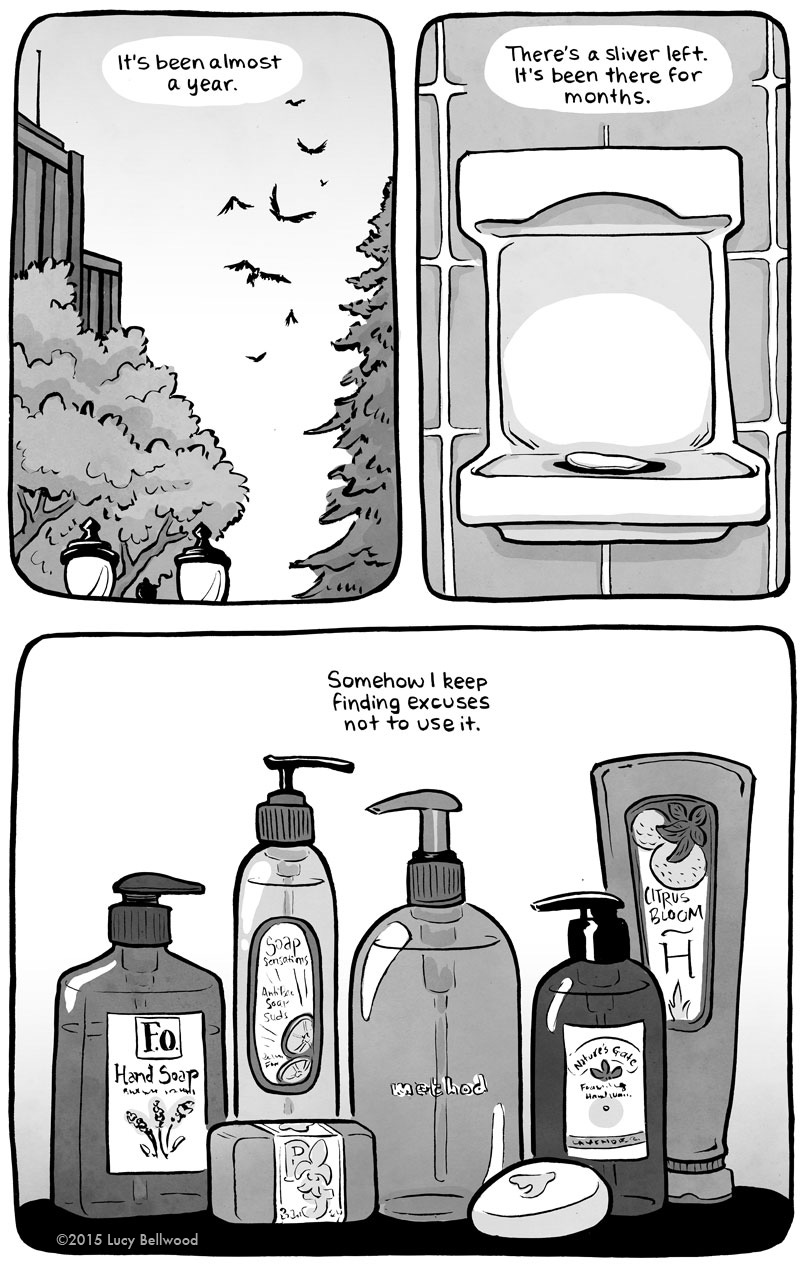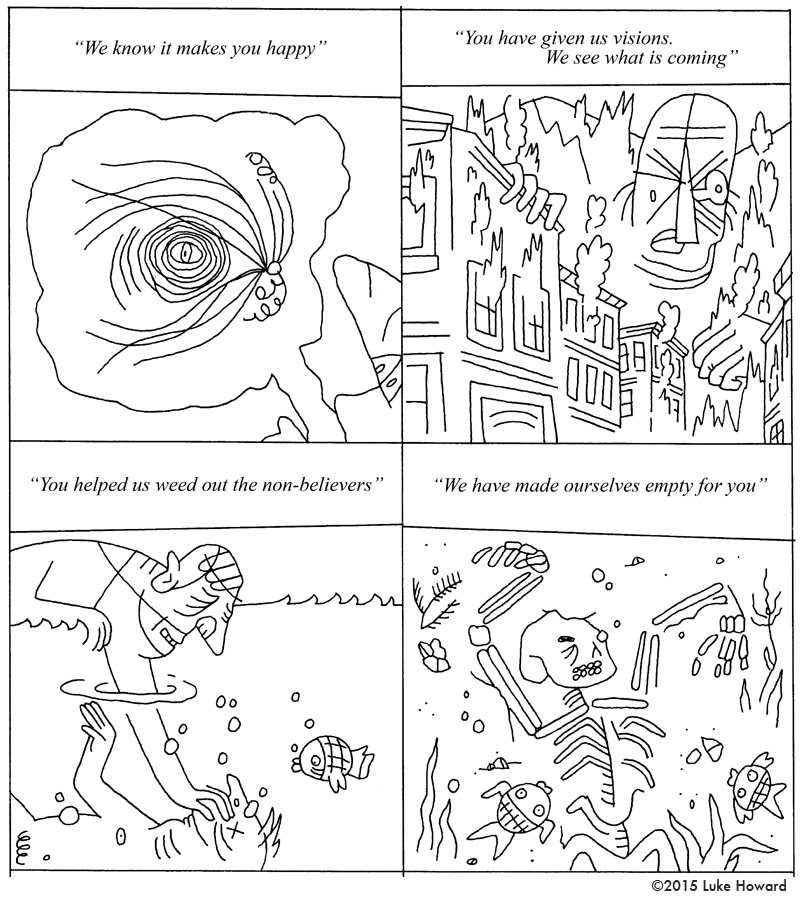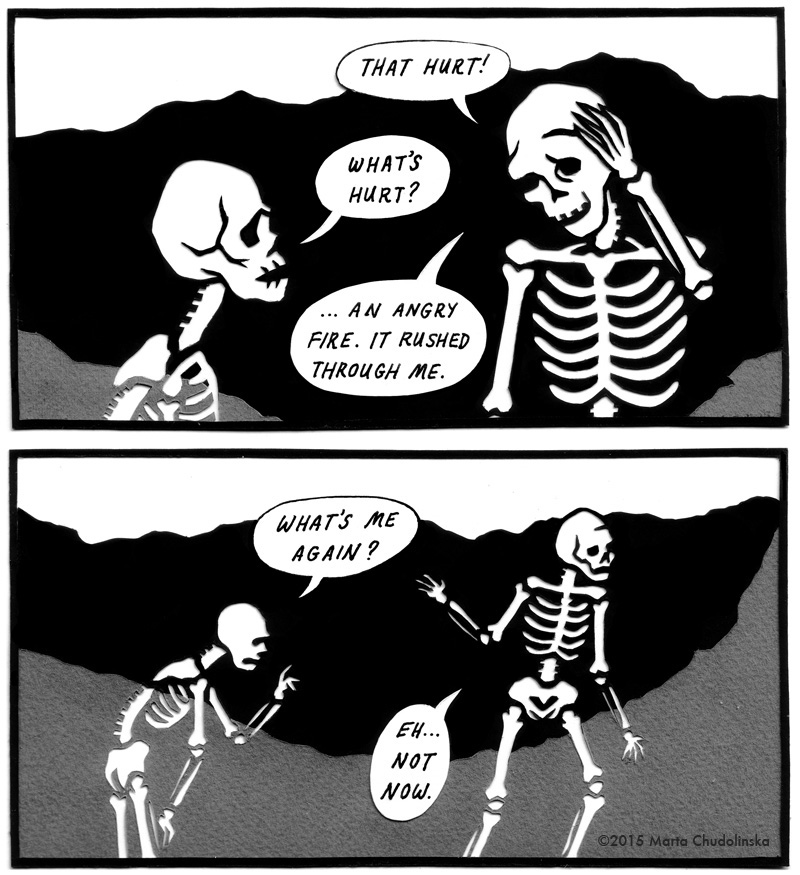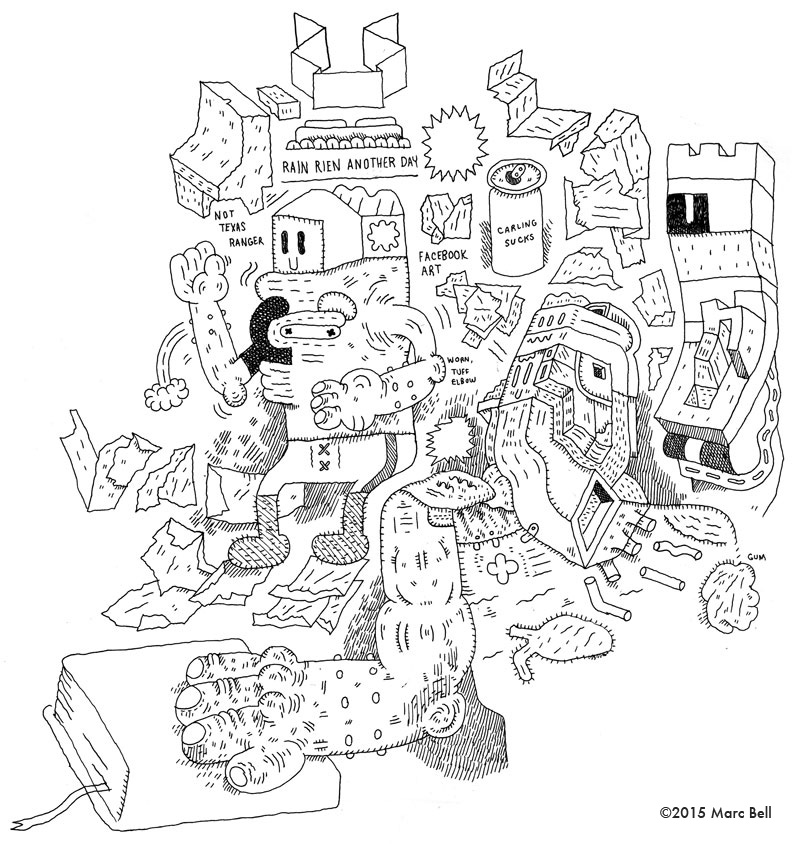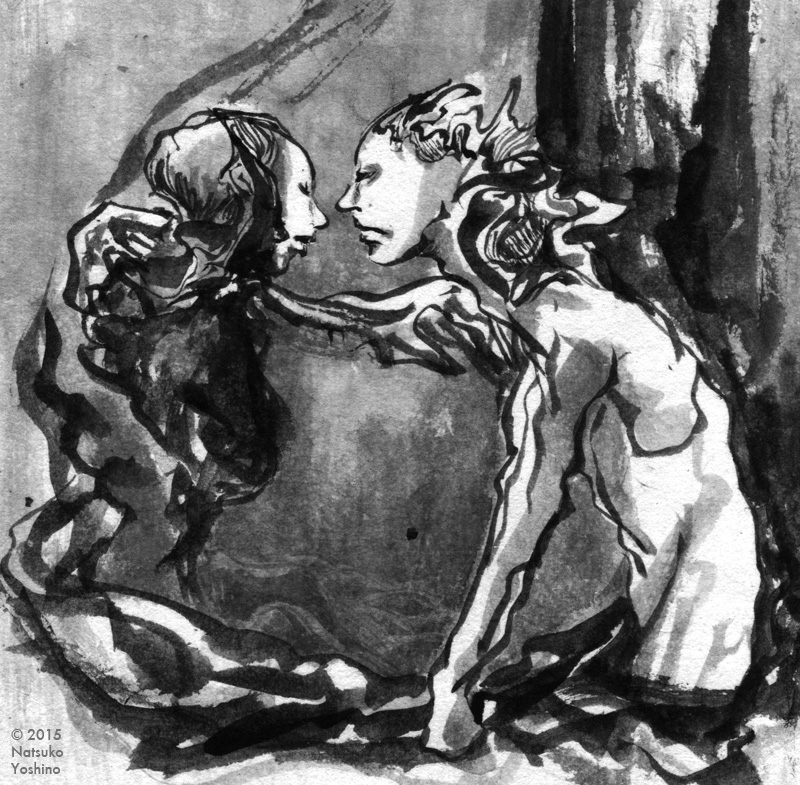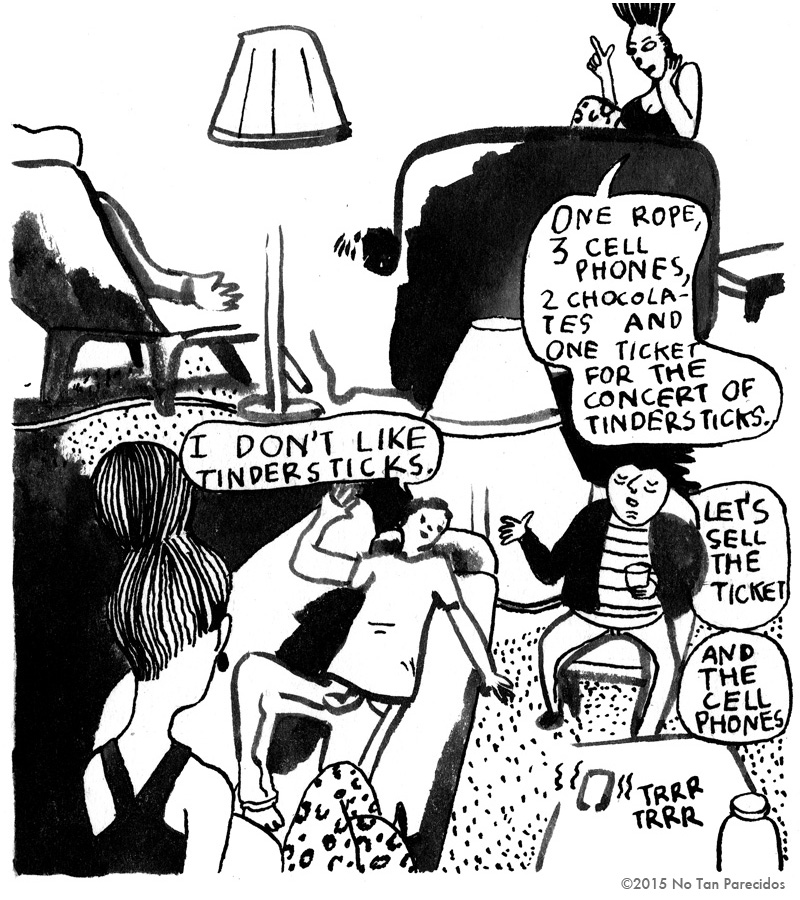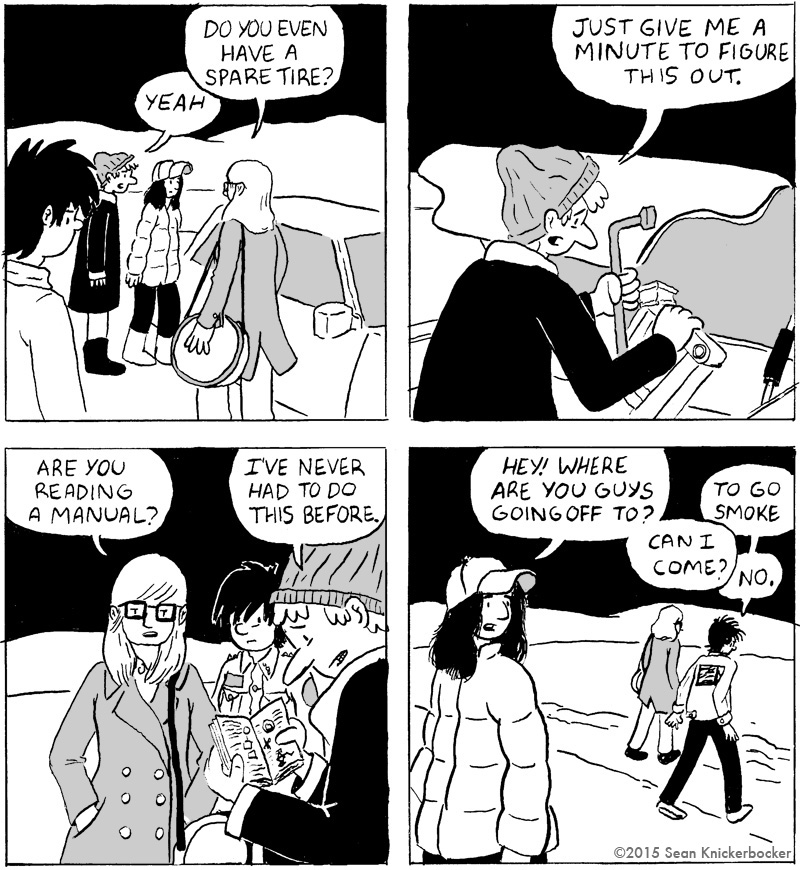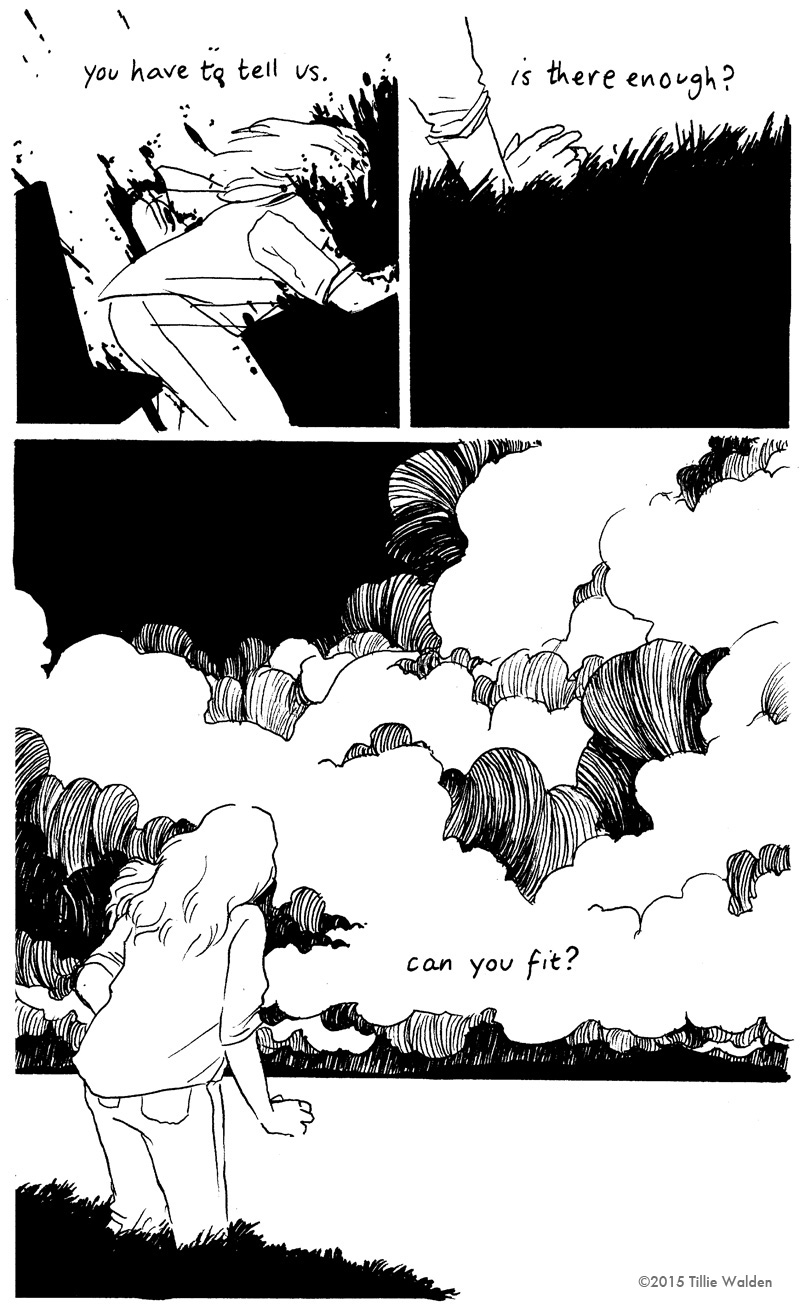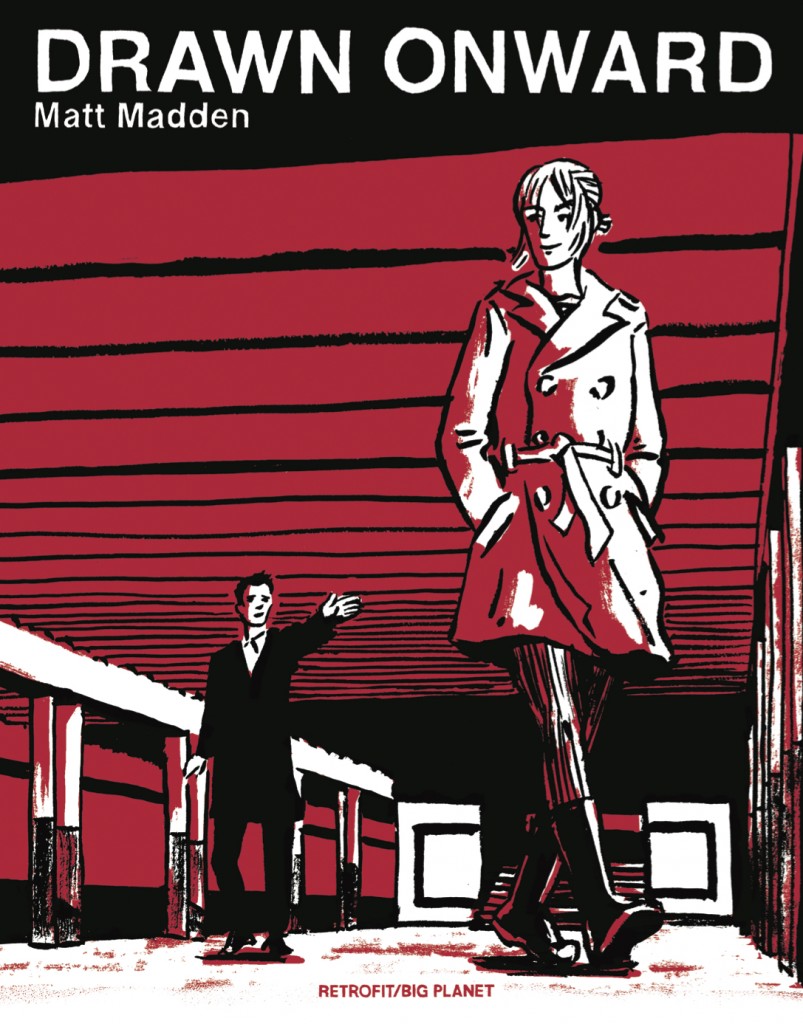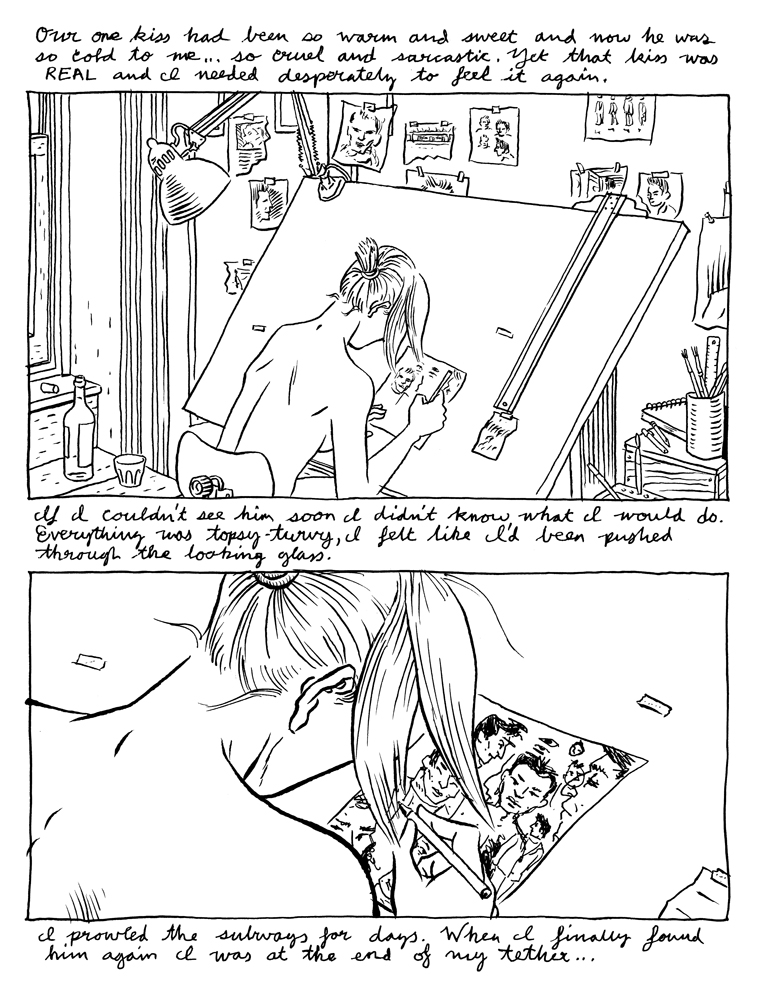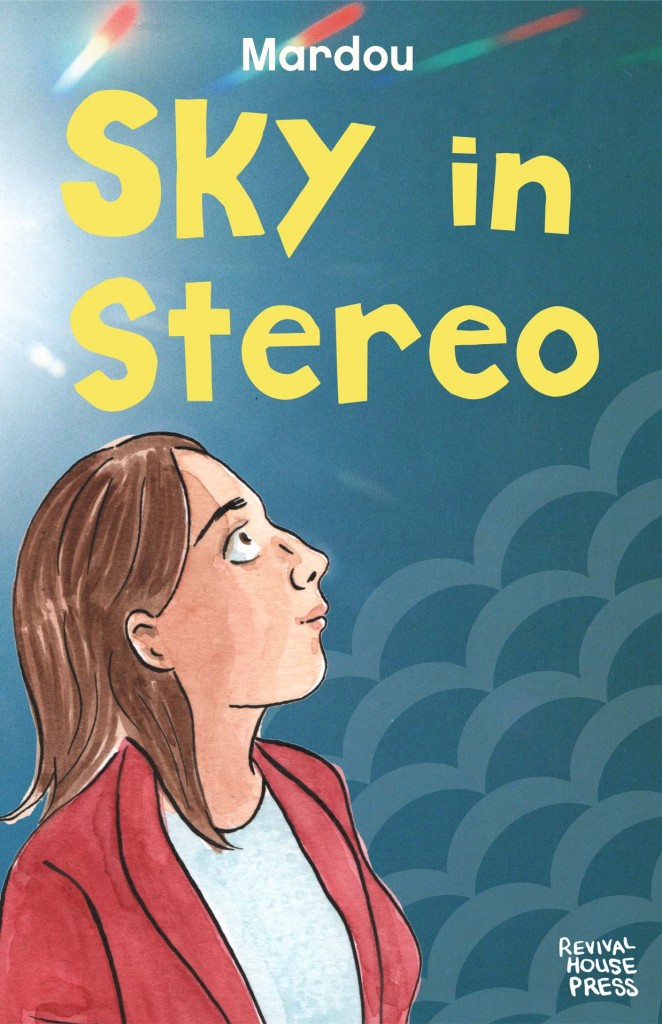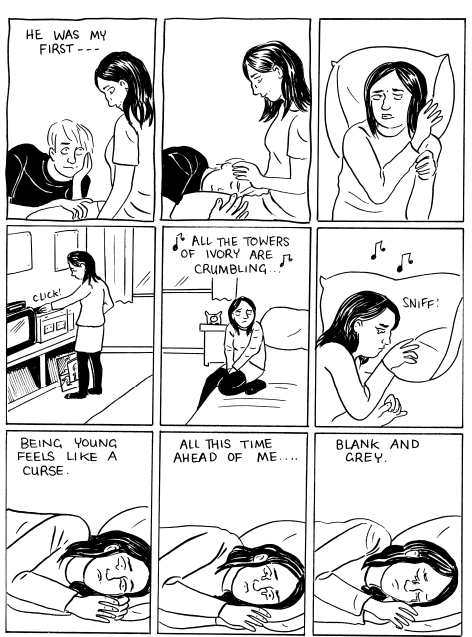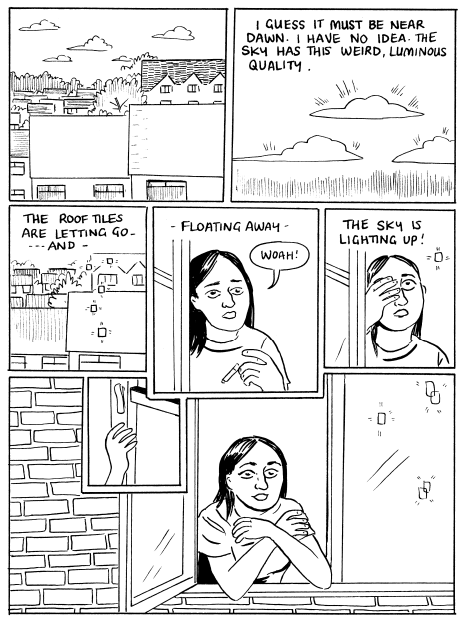Un primo sguardo a “Dog City” #4
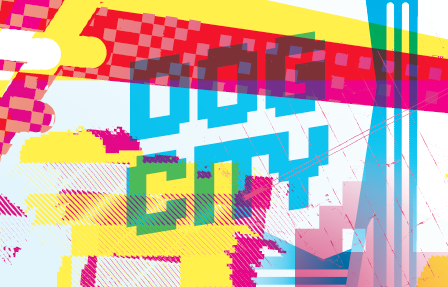
Non è proprio una preview perché il volume ha già debuttato qualche giorno fa alla Small Press Expo, ma quelle che trovate di seguito sono comunque alcune tavole dal quarto numero di Dog City, interessantissima antologia statunitense di cui ho già parlato in passato recensendo la terza uscita. In quel caso si trattava ancora del vecchio formato, una scatola di cartone contenente mini-comics di dimensioni e autori diversi, insieme a poster, riviste e stampe: una formula senz’altro originale ed esteticamente attraente, ma che presentava anche delle controindicazioni logistiche, dato che rendeva praticamente impossibile spedire il tutto fuori dagli Stati Uniti a causa dei costi decisamente elevati. Con questo quarto numero si è passati al più classico formato paperback, potenziato dall’utilizzo della piattaforma print-on-demand CreateSpace di Amazon che ha reso possibile una distribuzione facile e istantanea anche in Europa. E infatti Dog City #4 – come sempre curato da Simon Reinhardt, Luke Healy e Juan Fernández – è già disponibile su Amazon.it a un prezzo decisamente competitivo. All’interno troverete 7 fumetti, tutti frutto di collaborazioni a 4 mani tra 14 cartoonist e cioè Disa Wallander & Matt Davis, Luke Healy & Sasha Steinberg, Sarah Bowie & Iris Yan, Ed Cheverton & Dan Rinylo, Simon Reinhardt & Whit Taylor, Aaron Cockle & Juan Fernández, Caitlin Rose Boyle & Jennifer Lisa. Di seguito una tavola da ogni contributo.
First look at “Dog City” #4

This isn’t exactly a preview, since the book has already debuted some days ago at the Small Press Expo, but here you can find some images from the brand new issue of Dog City, edited as usual by Simon Reinhardt, Luke Healy and Juan Fernández. If the third issue, as the ones before, was made of a screen-printed cardboard box including mini-comics, prints and posters, the fourth anthology in the series is a standard paperback, available here in the USA but distributed also in Europe for the first time thanks to the print-on-demand service CreateSpace by Amazon. Inside you’ll find seven comics made by 14 different cartoonists. Every comic is a collaboration between two artists and in particular between Disa Wallander & Matt Davis, Luke Healy & Sasha Steinberg, Sarah Bowie & Iris Yan, Ed Cheverton & Dan Rinylo, Simon Reinhardt & Whit Taylor, Aaron Cockle & Juan Fernández, Caitlin Rose Boyle & Jennifer Lisa. Below a page from every comic in the book.
Il meglio del Web – 21/9/2015
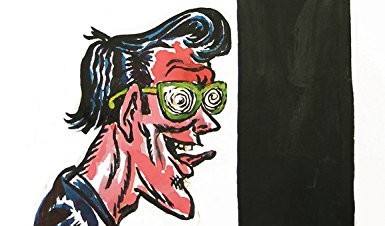
Si è conclusa ieri negli Usa la Small Press Expo, il principale evento dedicato al fumetto indie nord-americano. Dei vincitori degli Ignatz Awards ho già parlato in questo post, qui vi do invece qualche dritta se volete approfondire le novità che hanno debuttato a Bethesda. Una lista più o meno completa la trovate sul sito ufficiale dell’evento, mentre Sequential State dà qualche consiglio sugli acquisti e Panel Patter riepiloga tutti i post sulla SPX pubblicati nelle scorse settimane. Fino a stanotte Comixology offre uno sconto del 50% sulle versioni digitali di alcuni titoli di editori o artisti presenti all’evento (io ne ho approfittato per recuperare qualche titolo della Oily Comics di Chuck Forsman), mentre il cartoonist ed editore americano Box Brown ha reso gratuitamente disponibile su Gumroad il suo albo An Entity Observes All Things, candidato agli Ignatz nella categoria Outstanding Anthology or Collection.
E a proposito di fumetti americani, un estratto da Cretin: Keep on Creep’n Creek, la storia a puntate di Mat Brinkman per l’antologia Under Dark Weird Fantasy Grounds dell’italiana Hollow Press, sarà uno dei piatti forti del nuovo volume di The Best American Comics, in uscita il 6 ottobre e che oltre a Brinkman ospiterà lavori di Gabrielle Bell, Anya Davidson, Ed Piskor, Blaise Larmee, Josh Bayer e tanti altri. Un cast davvero notevole, messo in piedi dall’editor Bill Kartalopoulos e dal guest editor di quest’anno, lo scrittore Jonathan Lethem. A firmare la copertina addirittura Raymond Pettibon. Wow!
Un paio di crowdfunding in giro per il mondo. Negli Usa la 2d Cloud di Minneapolis ha inaugurato una raccolta fondi su Kickstarter per finanziare le pubblicazioni autunnali, tra cui si segnala una nuova rivista di critica e interviste, Altcomics Magazine. Disponibili anche a un prezzo speciale le ottime uscite primaverili, come 3 Books di Blaise Larmee, Salz & Pfeffer di Émilie Gleason e Qviet di Andy Burkholder. Peccato per le spese di spedizione inevitabilmente salate per noi europei.
Intanto in Italia La Trama lancia una nuova serie di Coppie miste, incentrata questa volta sulle collaborazioni tra Silvia Rocchi e Anna Deflorian, Alice Milani e Tuono Pettinato, Viola Niccolai e Federico Manzone, Francesca Lanzarini e Matteo Berton, Luca Caimmi e Victor Lejeune. Le prime tavole pubblicate da Fumettologica sembrano decisamente interessanti e in particolare mi incuriosce la singolare coppia Alice Milani-Tuono Pettinato, mentre Rocchi e Deflorian sembrano davvero perfette per lavorare insieme.
Sempre su Fumettologica segnalo l’anteprima di Sunday, nuova antologia di Delebile, questa volta sotto forma di spillato di 36 pagine a colori di grande formato, con tavole sul tema della domenica a opera di Bianca Bagnarelli, Paolo Cattaneo, Max de Radiguès, Aisha Franz, Roman Muradov, Nicolò Pellizzon, Alice Socal, Mickey Zacchilli. Sunday è ordinabile qui a prezzo scontato fino al 25 settembre e sarà in mostra al Treviso Comic Book Festival, evento che come al solito propone mostre e ospiti di livello dall’Italia e dall’estero, con focus sul fumetto olandese rappresentato da Joost Swarte e sull’inglese Nobrow.
Tra gli ospiti del TCBF c’è anche Paolo Cattaneo, che pubblica in questi giorni per Canicola L’estate scorsa. Sempre il colletivo bolognese fa uscire la prima storia lunga di Vincenzo Filosa, Viaggo a Tokyo. Sono molto curioso di leggerli entrambi.
Intanto date un’occhiata a questi due nuovi fumetti dell’argentino Berliac su Vice: Myrra e I Never Was In Mexico. Ho detto da tempo a Berliac che parlerò di lui più approfonditamente su Just Indie Comics: spero di riuscirci presto, così smetterò di sembrare un fanfarone.
Sul sito di comics journalism Graphic News, Pietro Scarnera disegna XO, An Introduction to Elliott Smith, incentrata sul pezzo Waltz #2. Leggete, guardate e ascoltate, ne vale la pena.
Rob Clough recensisce Truth Is Fragmentary di Gabrielle Bell, J. Caleb Mozzocco parla di Terror Assaulter: O.M.W.O.T. (One Man War On Terror) di Benjamin Marra, Joe McCulloch analizza dettagliatamente il progetto Electricomics che vede tra gli ideatori Alan Moore, Robert Kirby intervista Josh Simmons, Annie Koyama parla dei suoi libri preferiti.
E a proposito di Koyama Press, la primavera canadese sembra decisamente fiorente, con il nuovo libro di Patrick Kyle, una raccolta di zine di Aidan Koch e altre interessanti novità.
Assegnati gli Ignatz Awards 2015
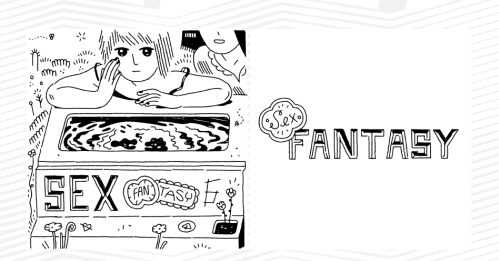
Trionfano le donne agli Ignatz Awards 2015, consegnati ieri sera all’annuale Small Press Expo. Le cartoonist nominate non hanno lasciato nemmeno un premio ai colleghi uomini e in alcuni casi hanno davvero fatto incetta del prezioso mattoncino, praticamente l’oscar del fumetto indie nord-americano. Sophia Foster-Dimino si è aggiudicata ben tre premi, mentre Sophie Goldstein, che già l’anno scorso aveva vinto un Ignatz per House of Women (come potete vedere da questa foto che avevo scattato in loco), ha portato a casa ben due riconoscimenti per il suo The Oven. Sophia e Sophie insomma, nemmeno a farlo apposta. Peccato che sia rimasto fuori ancora una volta Noah Van Sciver, che un premio l’avrebbe meritato. E il titolo di “oustanding anthology” sarebbe stato il giusto riconoscimento per il librone celebrativo della Drawn and Quarterly. Ma con i premi funziona così, si sa. Di seguito la lista completa, che può essere anche un’ottima occasione per recuperare materiale che avevamo tutti sottovalutato al momento dell’uscita.
Outstanding Artist
Emily Carroll, Through The Woods
Ed Luce, Wuvable Oaf
Roman Muradov, (In a Sense) Lost and Found
Jillian Tamaki, SuperMutant Magic Academy
Noah Van Sciver, Saint Cole
Outstanding Anthology or Collection
Drawn and Quarterly, 25 Years of Contemporary Cartooning, Comics, and Graphic Novels, edited by Tom Devlin, Chris Oliveros, Peggy Burns, Tracy Hurren and Julia Pohl-Miranda
An Entity Observes All Things by Box Brown
How To Be Happy by Eleanor Davis
Pope Hats #4 by Ethan Rilly
SuperMutant Magic Academy by Jillian Tamaki
Outstanding Graphic Novel
Beauty by Kerascoët and Hubert
The Oven by Sophie Goldstein
Rav by Mickey Zacchilli
Saint Cole by Noah Van Sciver
Wendy by Walter Scott
Outstanding Story
Doctors by Dash Shaw
Me As a Baby by Michael DeForge (from Lose #6)
Nature Lessons by Marguerite Van Cook and James Romberger (from The Late Child and Other Animals)
Sex Coven by Jillian Tamaki (from Frontier #7)
Weeping Flower, Grows in Darkness by Kris Mukai
Promising New Talent
M. Dean, K.M. & R.P. & MCMLXXI (1971)
Sophia Foster-Dimino, Sphincter, Sex Fantasy
Dakota McFadzean, Don’t Get Eaten by Anything
Jane Mai, Soft
Gina Wynbrandt, Big Pussy
Outstanding Series
Dumb by Georgia Webber
Frontier edited by Ryan Sands
March by John Lewis, Andrew Aydin and Nate Powell
Pope Hats by Ethan Rilly
Sex Fantasy by Sophia Foster-Dimino
Outstanding Comic
Borb by Jason Little
The Nature of Nature by Disa Wallander
The Oven by Sophie Goldstein
Pope Hats #4 by Ethan Rilly
Weeping Flower, Grows in Darkness by Kris Mukai
Outstanding Minicomic
Devil’s Slice of Life by Patrick Crotty
Epoxy #5 by John Pham
King Cat #75 by John Porcellino
Sex Fantasy #4 by Sophia Foster-Dimino
Whalen: A Reckoning by Audry
Outstanding Online Comic
The Bloody Footprint by Lilli Carré
Carriers by Lauren Weinstein
Mom Body by Rebecca Roher
O Human Star by Blue Delliquanti
Witchy by Ariel Ries
Just Indie Comics online shop is born
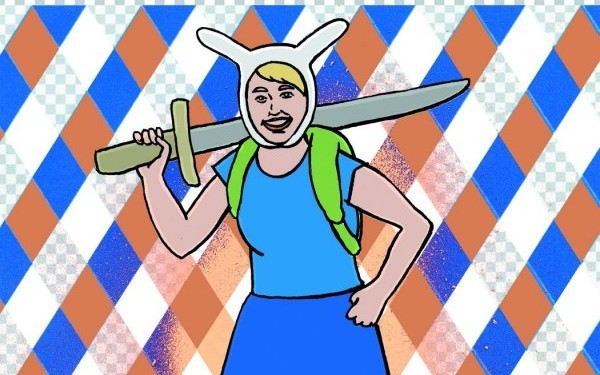
After a long time in the making, I finally managed to inaugurate an online shop, where you’ll find more or less the comics I’m usually talking about on the website. I’m saying more or less because there won’t be a direct link between the comics on the blog and the ones available in the shop. Just Indie Comics won’t lose its informational and critical contents, even if I didn’t write so much “critic” so far, since I’m mostly trying to spotlight the comics I like. Moreover, one of the goals of this initiative is to enhance the website. I hope to have a lot more reviews around here, thanks to the close connections I’m creating with cartoonists, publishers and distros.
At the moment you can find in the shop a lot of comics from USA and Canada. I think this was pretty obvious, since I’m talking mostly about the North-American scene and for that I’ve called the website “Just Indie Comics”. So the shop is addressed to European readers, who can order from me comics not to be found in other European websites or shops at the moment, sparing very expensive shipping rates and maybe also some customs costs.
At the moment I’ve in the shop some issues of the Frontier anthology published by Youth In Decline (the ones by Anna Deflorian and Emily Carroll, while issue 7 by Jillian Tamaki is sold out), two comics by Antoine Cossé (Harold and Showtime #1), On Topics by Michael De Forge published by Breakdown Press, the two issues of Cosplayers by Dash Shaw published by Fantagraphics Books, Night Animals by Belgian artist Brecth Evens, Drawn Onward by Matt Madden and Wicked Chicken Queen by Sam Alden published by Retrofit Comics, the second and the third issue of the series Ritual by Malachi Ward published by Revival House Press, the Killoffer’s issue of Mon Lapin, and some bigger books at special prices, like Lapsos by Inés Estrada, Distance Mover by Patrick Kyle, Co-Mix by Art Spiegelman, The Wild Kingdom by Kevin Huizenga, Bumperhead by Gilbert Hernandez, Everything Together by Sammy Harkham. All the comics are new and come directly from the publishers or from some American distros, like John Porcellino’s Spit and A Half. Take a look at the website for a full list, while if you want to hear about the new arrivals you can like the Facebook page of the shop. In the next weeks, I’ll have new comics from Hic & Hoc Publications, One Percent Press, Hollow Press and a lot of other titles, including the fourth issue of the Mould Map anthology published by Landfill Editions. Stay tuned!
Anteprima di “Irene” #6
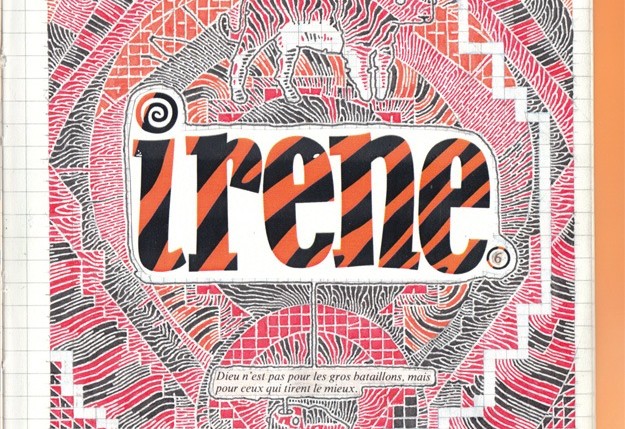
Debutterà questo weekend alla Small Press Expo di Bethesda, nel Maryland, il sesto numero di Irene, curato come sempre da Andy Warner, dw (autore della cover qui sopra) e Dakota McFadzean. In passato ho già parlato di questa antologia, di cui ho recensito il terzo e il quarto numero, e già allora l’ho definita come una delle realtà più interessanti nell’attuale panorama del fumetto indie nord-americano. In attesa di avere tra le mani il nuovo volumetto, vi propongo di seguito alcune immagini di quella che si preannuncia come l’uscita più imponente della serie, dato che avrà ben 216 pagine e ospiterà i contributi di autori da tutti i continenti, incluso l’Antartide. Buona visione.
“Irene” #6 preview

The newest issue of Irene anthology will debut this weekend at Small Press Expo in Bethesda, Maryland. This is undoubtedly the biggest Irene yet, with 216 pages and contributors based in every continent on the planet Earth, even Antarctica. Contributors include: Marc Bell, Lucy Bellwood, Nick Cartwright, Marta Chudolinska, d.w., Jai Granofsky, Leif Goldberg, Luke Howard, Ben Juers, Sean Knickerbocker, Dakota McFadzean, Lena Merhej, No Tan Parecidos, Carolyn Nowak, Katie Parrish, Ben Passmore, Jackie Roche, Shennawy, Frøydis Sollid Simonsen, Kevin Uehlein, Tillie Walden, Andy Warner, and Natsuko Yoshino. Irene is edited by Andy Warner, dw, and Dakota McFadzean. When I reviewed the third and the fourth issue of this comics and art anthology I defined it as one of the best publications in the North-American indie comics scene, so I’m really looking forward to read the new book. For now you can take a look at some preview pics below and pre-order Irene #6 here.
“Drawn Onward” di Matt Madden
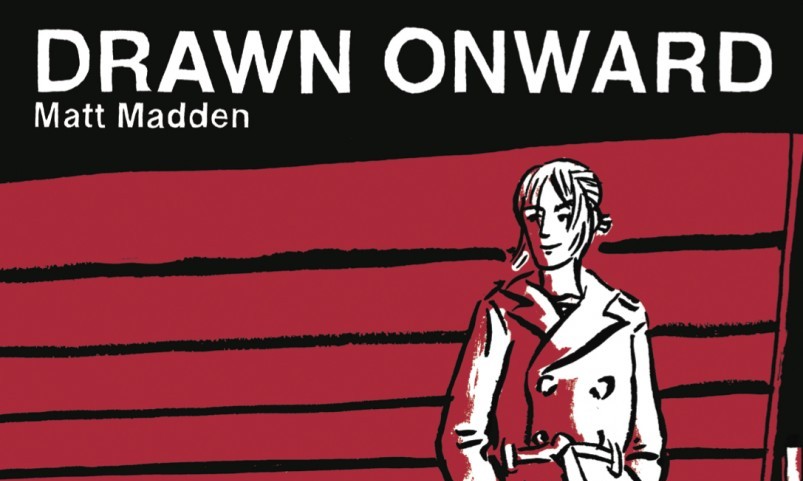
Drawn Onward è un comic book di Matt Madden pubblicato inizialmente come 182esimo numero della rivista One Story nel novembre 2013 e ristampato qualche mese fa da Retrofit Comics. Una donna incontra nei sotterranei della metropolitana uno sconosciuto, che ogni volta sembra riconoscerla tanto da implorare la sua attenzione e da dirle che non può vivere senza di lei. Detta così la storia potrebbe sembrare un mystery, costruito sul misterioso legame tra i due personaggi. In realtà Drawn Onward non è un fumetto incentrato sul plot ma sulla forma. Madden, che ai lettori italiani sarà familiare soprattutto per Esercizi di stile. 99 modi di raccontare una storia pubblicato da Black Velvet, realizza qui il suo ennesimo saggio in forma di fiction. D’altronde le sue opere sono spesso esperimenti che analizzano le strutture del fumetto e questo suo approccio alla narrativa disegnata ha trovato ancora più sfogo da quando il cartoonist statunitense si è trasferito ad Angoulême con la moglie Jessica Abel. Così, quando la protagonista comincia a ricambiare le attenzioni dello sconosciuto, il loro interesse diventa reciproco e sfocia nel bacio che occupa le pagine centrali dell’albo. Subito dopo, la prospettiva si ribalta. Ora è la donna a cercare l’uomo, che dal canto suo inizia a ignorarla e pian piano a respingerla. Ogni tavola della seconda metà del comic book diventa così speculare alla tavola corrispondente della prima parte, in un gioco di rimandi che ribalta i ruoli e trasforma quello che sembrava inizialmente un thriller in un sottile gioco da Settimana Enigmistica. L’alternarsi studiato di tavole disegnate con uno stile pulito e leggero e di altre caratterizzate da linee corpose fa il resto, rendendo a tutti gli effetti Drawn Onward un fumetto incentrato sulla struttura più che sulla narrazione.
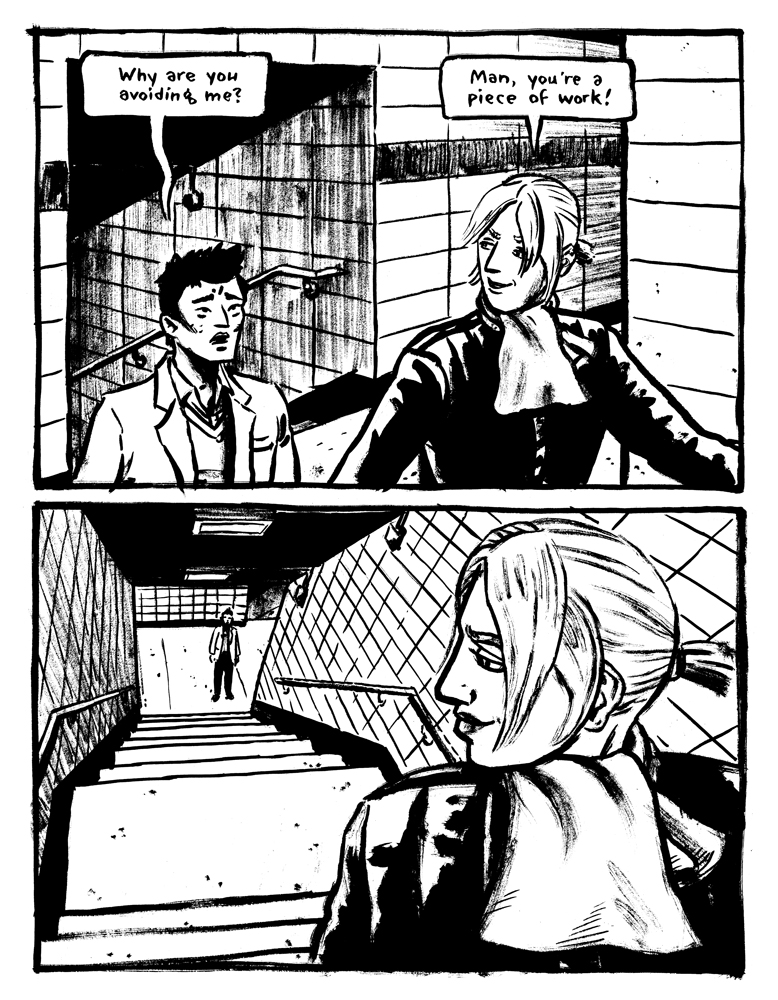 Nella versione originale la storia usciva con il sottotitolo di “star-crossed comic”, evidenziando il rapporto maledetto dal destino che lega i due protagonisti, mentre la nuova edizione è stata presentata come un fumetto palindromo. Tra le due definizioni la seconda è vera soltanto in parte, perché le pagine di apertura e chiusura contestualizzano la lettura e la rendono pienamente comprensibile soltanto se fatta “in avanti”, come suggerisce il titolo. Risulta invece azzeccatissima la definizione originale, dato che Drawn Onward si fa apprezzare più che per la dimensione formale – sinceramente un po’ fine a se stessa e neanche troppo originale – per il suo significato di parabola sui rapporti sentimentali, mostrando come a volte la sintonia duri soltanto per lo spazio di un bacio, dato tra le pagine centrali di un fumetto.
Nella versione originale la storia usciva con il sottotitolo di “star-crossed comic”, evidenziando il rapporto maledetto dal destino che lega i due protagonisti, mentre la nuova edizione è stata presentata come un fumetto palindromo. Tra le due definizioni la seconda è vera soltanto in parte, perché le pagine di apertura e chiusura contestualizzano la lettura e la rendono pienamente comprensibile soltanto se fatta “in avanti”, come suggerisce il titolo. Risulta invece azzeccatissima la definizione originale, dato che Drawn Onward si fa apprezzare più che per la dimensione formale – sinceramente un po’ fine a se stessa e neanche troppo originale – per il suo significato di parabola sui rapporti sentimentali, mostrando come a volte la sintonia duri soltanto per lo spazio di un bacio, dato tra le pagine centrali di un fumetto.
Drawn Onward è disponibile qui nel negozio di Just Indie Comics.
Drawing in the sky – Un’intervista con Mardou
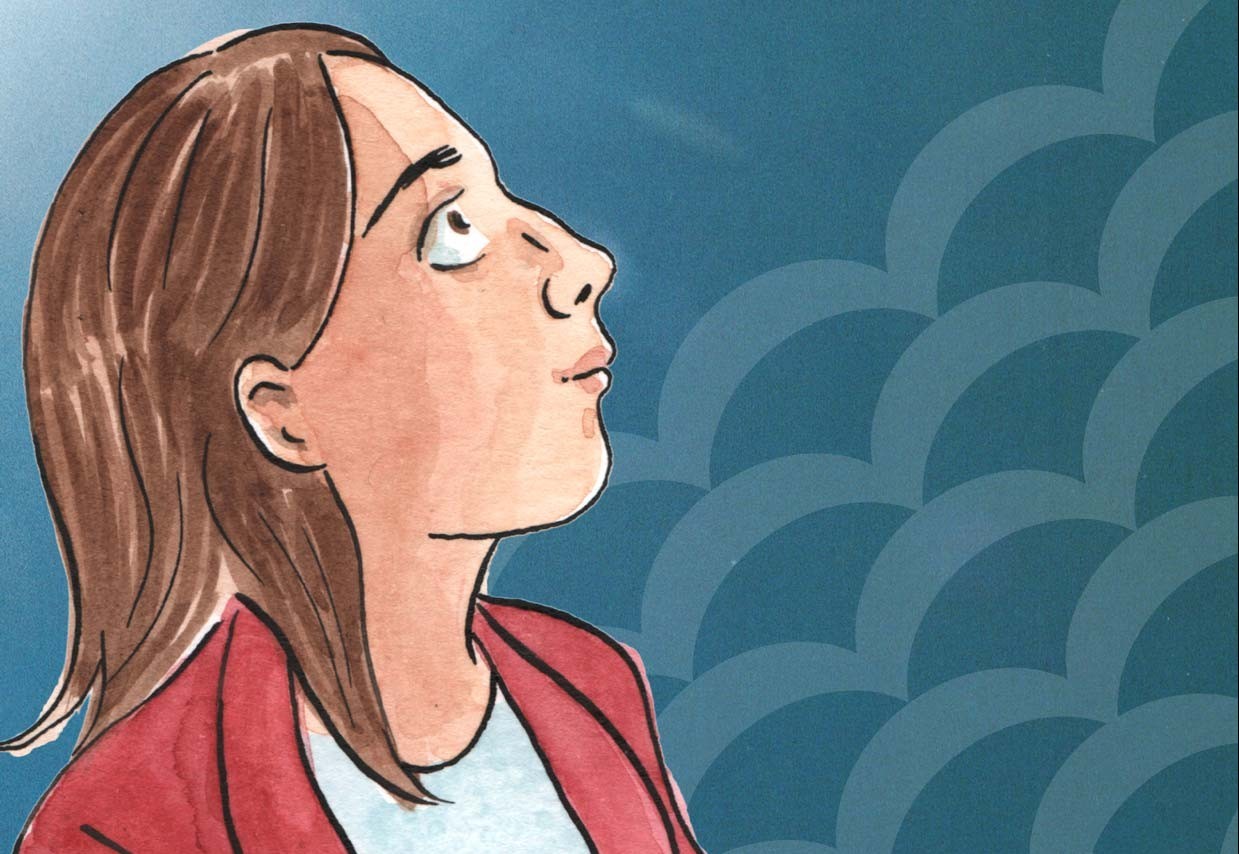
Ho scoperto i fumetti di Sacha Mardou (in arte solo Mardou) con il secondo numero di Sky In Stereo, pubblicato da Yam Books dopo l’esordio autoprodotto. Quel mini-comic conteneva la scena in cui la protagonista prendeva l’acido e cominciava a vedere strani segni nel cielo, iniziando un vagabondaggio quasi liberatorio per le strade di Manchester, Inghilterra, dove era ambientato il fumetto e dove è cresciuta l’autrice. Quel momento così libero, quella fuga, quell’assolo proposto con tanta abilità da Mardou mi fece capire che avevo davanti agli occhi un talento cristallino. La lettura del primo numero mi confermò quell’impressione: le vicende di Iris erano raccontate con un’abilità nella costruzione dei dialoghi, una leggerezza e una scorrevolezza difficili da trovare altrove, soprattutto se si tiene conto che dietro a quella leggerezza si nascondevano temi importanti come amore (soprattutto per il collega di fast-food Glenn), droga (dall’ecstasy agli acidi fino all’eroina) e adesso anche religione. Dico “adesso” perché Sky In Stereo sta finalmente tornando in pista, ma non con il terzo numero che ci potevamo aspettare, quanto con un’edizione definitiva in due volumi pubblicati da Revival House Press. Il primo esce in questi giorni e contiene un lungo prologo inedito, i due mini-comics e quello che doveva essere il terzo numero, per un totale di 182 pagine. L’ho letto in anteprima e ne ho parlato con l’autrice.
Ciao Sacha, dato che questa intervista è in qualche modo un’anteprima del vol.1 di Sky In Stereo, lascerei a te l’onore di introdurre il libro a chi non lo conosce.
Ciao Gabriele, Sky In Stereo è un graphic novel in due parti che parla di un’adolescente chiamata Iris, del suo lavoro schifoso, della sua vita scolastica e infine del suo esaurimento nervoso. Sembra deprimente ma non lo è. Ci sono diversi momenti positivi lungo il percorso.
La prima cosa che mi viene in mente parlando di Sky In Stereo è che diversi elementi possono sembrare autobiografici, a partire dal fatto che la storia è ambientata a Manchester, in Inghilterra, dove sei nata e cresciuta. Ma al di là del sapere quanto c’è di autobiografico nelle vicende di Iris, a me piacerebbe chiederti se il materiale di Sky In Stereo parte da qualcosa che hai scritto o disegnato durante gli anni del college, per esempio un diario o uno sketchbook, perché alcune parti sono veramente accurate e realistiche.
No, non tenevo un diario a quei tempi. Molti degli eventi più importanti sono tratti dalla mia vita, ma ho fatto la scelta di trasformarli in fiction. Inoltre questo materiale guarda parecchio indietro, a più di venti anni fa. Non posso ricordare conversazioni fatte all’epoca, e così diventa invenzione. La fiction mi ha dato molta più libertà nell’esplorare da una prospettiva diversa gli aspetti più complicati della vita reale, comprimendoli in qualcosa di più semplice, una storia che inizia e finisce.
Molti personaggi sono inventati, come per esempio Doug, il patrigno di Iris. Mia madre era sposata con un tipo, ma era molto diverso da Doug. Mi piace molto quel personaggio in realtà, è stato divertente scriverlo e i continui battibecchi tra lui e la mamma di Iris aiutano a rivelare i motivi delle decisioni di Iris nella storia. Mia mamma è una Testimone di Geova nella vita reale, ma non è come Gina. Gina è abbastanza devota e conservatrice, l’ho descritta così per renderla funzionale alla storia. Mia mamma invece è adorabile e ho un rapporto molto stretto con lei. L’ho sempre avuto.
Sono contenta che la storia sembri vera comunque, mi piace l’idea che la gente ci si possa riconoscere.
Sì, tutta la storia sembra reale e alcune parti sono molto vivide, penso per esempio alla rottura tra Iris e John, che ha una dimensione emotiva molto forte…
Grazie. Penso che crescendo dimentichiamo quanto è intenso l’amore da giovani. Lì ho cercato proprio di catturare l’intensità e la futilità di quel sentimento.
Questa prima parte, in cui esplori l’ambiente familiare e l’educazione religiosa di Iris, è inedita, infatti Sky In Stereo #1 si apriva con quello che adesso è il secondo capitolo, quando Iris è in macchina con le amiche prima di entrare in un locale. Come ti è venuta l’idea di realizzare questa specie di prequel?
Ho sempre avuto l’intenzione di raccontare la storia dall’inizio, ma quando ho disegnato i mini-comics ho pensato che sarebbe stato più interessante cominciare direttamente nel mezzo dell’azione. Nel secondo libro (ho già le bozze pronte e lo disegnerò e inchiostrerò in autunno), il tema religioso tornerà nel periodo trascorso da Iris all’ospedale psichiatrico. Il manoscritto originale era molto più voluminoso e andava anche più indietro, a quando Iris aveva sette anni e i sui genitori stavano divorziando. La storia com’è adesso è venuta fuori durante l’editing. Ho tagliato due interi capitoli di circa 100 pagine totali, di cui avevo già fatto le bozze e che mi piacevano molto. “Evvai, almeno non devo disegnare tutta questa roba!”. E penso che alla fine il libro sia venuto meglio così.
A questo proposito un momento importante è quando Iris scopre L’età della ragione di Sartre e le sue certezze religiose vengono meno, mi ci sono ritrovato molto in quella parte, dato che a parecchie persone è capitato, intorno ai 14-15 anni, di mettere in discussione gli insegnamenti tramandati dalla famiglia e dalla società dopo essersi avvicinato a certi romanzi o testi filosofici.
Sì, ho letto un libro veramente importante per me, Confessions of a Teenage Jesus Jerk di Tony Du Shane ed è esattamente quello che succede a lui: dopo aver letto un libro dalla cattiva reputazione ha cominciato a mettere in discussione la sua famiglia di Testimoni di Geova. A dire il vero ho letto il libro dopo aver scritto Sky In Stereo, ma l’ho trovato molto vicino.
Un’altra scena centrale è quella in cui Iris prende l’acido, non a caso le sue visioni del cielo danno il titolo al libro. All’inizio è fatta, felice, esaltata, ma con il passare del tempo è come se questa esperienza le abbia dato non solo “buone vibrazioni” ma anche una nuova consapevolezza, come se l’acido le avesse mostrato la strada per lasciare da parte la sua insicurezza…
E’ come si sente il giorno dopo, si sente speciale e positiva. Ma poi nei giorni seguenti non ha dormito né mangiato… La fiducia in se stessi quando è euforica non dura. Non può durare.
E infatti questo apre la strada al suo esaurimento, che sarà il tema del secondo volume…
Sì, il secondo volume avrà le stesse pagine del primo e vedrà Iris rinchiusa durante l’estate. C’è un estratto di tre pagine alla fine di questo libro che dà l’idea di cosa succederà. Per certi versi mi sono lasciata influenzare da La campana di vetro di Sylvia Plath.
Iris ascolta un sacco di musica dei primi anni ‘90, ci sono riferimenti ai Pixies, ai Blur, ai Pavement, agli Orbital, al Nick Cave solista… Ma ci sono anche David Bowie e i Velvet Underground… Tu cosa ascoltavi al college?
Tutta questa roba, tranne gli Orbital. La techno e la dance ancora andavano forte a Manchester, anche se il boom c’era stato all’inizio degli anni ’90. Non sono mai stata coinvolta in quelle scene. La canzone dei Pulp Sorted For E’s & Wizz era molto realistica, non per me magari, ma vedevo quel tipo di cultura intorno a me. Mi ricordo di aver letto un’intervista a Nick Cave degli anni ’90 e lui raccontava di aver iniziato a fare a botte con qualcuno dopo aver provato l’ecstasy. Ahah, è lui il mio tipo!
E che mi dici degli Smiths? Non so se ti piacevano, ma ci sono alcuni momenti che potrebbero essere tratti da un testo di Morrissey, per esempio quando alla fine del primo capitolo Iris pensa “He was my first… Being young feels like a curse. All this time ahead of me… Blank and grey”. E sono di Manchester anche loro…
Erano in giro un po’ prima di me e non sono mai stata una fan. Le chitarre di Johnny Marr mi hanno sempre urtato i nervi. Mi piacciono i Joy Division e i New Order, che erano altri due gruppi importanti di Manchester. Quando ero al liceo andavano forte gli Happy Mondays e i James. Alla fine il fumetto è ambientato a Manchester, e la musica è in qualche modo strettamente legata alla città. Era un posto dove suonavano tante band e da lì sono nati grandissimi gruppi. E questo ha dato a questa città altrimenti poco importante un senso di se stessa.
E’ difficile da spiegare ma ho cercato di rendere la musica parte del tessuto del libro nello stesso modo il cui la musica è intrecciata alla cultura della città di Manchester.
Facendo un passo indietro, purtroppo ho conosciuto i tuoi lavori soltanto con gli albetti di Sky In Stereo, ma so che prima hai realizzato parecchi lavori, come Anais In Paris e Manhole. Ho visto on line qualche storia breve tratta dall’antologia tutta al femminile Whores of Mensa e sono molto diverse, si tratta di brevi racconti più estemporanei, mentre le tue ultime cose sono molto incentrate sulla narrazione. C’è qualche artista a cui ti ispiravi in modo particolare ai tempi di Whores of Mensa e come sei arrivata poi a sviluppare uno stile così narrativo?
Dan Clowes e Julie Doucet erano due delle mie fonti di ispirazioni. Ma erano entrambi degli artisti incredibili. Ho capito che la mia forza era la scrittura e così trovare uno stile grafico da mettere al servizio delle mie storie diventò il mio obiettivo di lungo termine. E lo è ancora!
In tal senso questa prima raccolta di Sky In Stereo segna una crescita dal punto di vista stilistico, mi sembra che le parti inedite poi siano più curate, come se con il passare del tempo il tuo stile stesse diventando più meticoloso…
Sono molto più a mio agio con il mio stile adesso, e penso che si veda. Scoprire il lavoro di Gabrielle Bell circa dieci anni fa è stato veramente importante per me. Non che io stia cercando di imitarla, ma c’è quella rassicurante sensazione di scorrevolezza nel suo disegno che mi ha davvero ispirato. E non si sforzava di disegnare, le bastava essere se stessa. Mi ha formato!
Inoltre penso di aver inconsapevolmente preso alcune cose da Ted May, mio marito. E’ un artista incredibilmente bravo, io non sono al suo livello. Ma stavo guardando al modo in cui disegno gli occhi adesso e ho capito che l’ho ripreso da Ted in tutto e per tutto.
Beh, siamo sposati quindi sono autorizzata, o almeno credo.
Beh, non credo che ti farà causa. Il paragone con Gabrielle Bell è perfetto, lei è una delle mie cartoonist preferite e sia le tue storie che quelle di Gabrielle sono scorrevoli, leggibili e mai noiose. Inoltre siete due artiste molto abili nel rendere il linguaggio del corpo…
Grazie, mi piace veramente tanto il suo lavoro, e poi ha avuto una vita così interessante. Hai notato che Gabrielle raramente usa i primi piani? Nella maggior parte delle sue vignette disegna figure intere o a tre quarti. Mi ricorda Ozu, i suoi film erano così.
Ok, siamo quasi alla fine dell’intervista e ne approfitto per chiederti se c’è qualcosa che ti è piaciuto davvero negli ultimi tempi, qualche fumetto oppure un romanzo o un film.
Everywhere Antennas di Julie Delporte è meraviglioso, l’ho adorato. E Paul Joins the Scouts di Michel Rabagliati è formidabile. Lui è uno scrittore e un cartoonist davvero bravo. Mi piace molto anche il lavoro di Melissa Mendes.
Ted sta lavorando al prossimo numero di Men’s Feelings e ne sto leggendo qualche pezzo quando mi avvicino di nascosto alla sua scrivania. E’ grandioso!
E per quanto riguarda la narrativa? Ho letto che hai studiato letteratura inglese al college, quindi sarei curioso di sapere se c’è qualche romanzo che hai apprezzato di recente o qualcosa a proposito dei tuoi autori preferiti.
Mi piace leggere tutto di un autore, partendo da qualsiasi cosa abbia scritto per passare poi alla sua biografia o autobiografia. Negli ultimi due anni ho letto tutta Doris Lessing, è probabilmente la mia persona preferita di sempre. O comunque è nella top five. Il suo libro Shikasta è diverso da qualsiasi cosa io abbia letto in precedenza.
Mi piace molto anche John Updike, alcuni lo hanno accusato di sessismo perché era un gran donnaiolo ma in realtà descriveva i suoi personaggi femminili in modo molto realistico. Cioè, se leggi le cose di Erica Jong scritte negli stessi anni i personaggi sembrano datati e stucchevoli. Invece le casalinghe di Updike sembrano reali e riescono a commuovere.
Leggo parecchi libri per bambini con mia figlia. Adoriamo la serie The Borrowers e in questo momento stiamo per finire i romanzi dei Moomins, Tove Jansson era grandiosa. Quei libri hanno ispirato i miei sogni. L’altra notte ho sognato un’altra volta tesori sommersi, quindi grazie Tove!
A proposito di sogni, in Italia abbiamo un famoso presentatore, Gigi Marzullo, che faceva un programma televisivo notturno in cui intervistava a lungo i suoi ospiti, spesso facendo domande abbastanza assurde. E una di queste era proprio “la vita è un sogno o i sogni aiutano a vivere meglio?”. Concludeva ogni intervista con la classica “si faccia una domanda e si dia una risposta”. Mi piacerebbe provare quest’ultima, che ne dici?
D- Hai visto qualcosa di fico di recente?
R- Ieri ho disturbato due coccinelle che si stavano accoppiando nel mio giardino. Stavo guardando le mie piante di cetriolo per vedere se ce n’era qualcuno pronto per essere colto e ho trovato questa coppia che si era appartata, si erano infilate in un angolo nascosto vicino a un cespuglio, coperte da una foglia. Una era giallognola con un sacco di macchie e la femmina era rossa con due chiazze. E mi è sembrata davvero una cosa fica.
Drawing in the sky – An interview with Mardou

I discovered Mardou with the second issue of Sky In Stereo, released by Yam Books after the first self-published mini-comic. That book included the scene where Iris – a teenage girl based in Manchester, England – took acid and started to wander, confused but happy in the streets of the city. That free moment, artfully depicted by Mardou, could have been a fugue in a piece of classical music or a solo in some rock song and it made me realize I was staring at a sharp and genuine talent with an unique ability to write dialogue and to render body language. After locating and reading the first issue, my initial impression was confirmed. Iris’s story was once again told with a lightness and a fluidity that seems hard to find, especially when you consider that behind the lightness there are big issues at play, such as love (for her fast-food coworker Glenn), drugs (ecstasy, acid but also heroin) and now, religion. I say “now” because Sky In Stereo is finally back on track with a definitive edition in two volumes published by Revival House Press. The first will be available in October, featuring a 180-page story with an unreleased prologue, the two previously-mentioned mini-comics and the never-published third issue. I read a preview and I talked about it with Mardou.
Hello Sacha, since this interview is a sort of preview of Sky In Stereo vol. 1, I’ll leave it to you to introduce the book.
Hi Gabriele, Sky in Stereo is a two part graphic novel about a teenager called Iris, her crummy job and school life and her slide into a mental breakdown. It sounds depressing but it’s not. There’s some good times along the way.
The first thing that comes to my mind talking about Sky In Stereo is that many parts may seem autobiographical, starting with the fact that the story takes place in the ’90s in Manchester, England, where you grew up. Anyone can speculate about how much of the book is autobiographical… Instead I’d like to ask you if Sky In Stereo takes its cue from some diary, novel or comic you have written and/or drawn during your college years, because some parts seem very accurate and true to life.
Nope, I didn’t keep a journal back then. Many of the main events are taken from my own life but I made a choice to turn this into fiction. Plus you know, this material goes a long way back, over twenty years. I can’t remember conversations from that long ago, so it becomes invention. Fiction gave me much more freedom to explore true things from a different angle and also compress the unwieldy aspects of real life into something simpler, a story with its own arc.
Many characters are made up, Iris’s stepdad Doug for instance. My mum was married to a guy but he was very different to Doug. I really like that character actually, he was fun to write and the bickering between him and Iris’s mum really helped reveal aspects of Iris’s decisions in the story. My own mum IS a Jehovah’s Witness in real life but she’s not like Gina. Gina’s quite staunch and conservative. It served the story to make her that way. My mum in real life is lovely and I have a pretty close relationship with her. Always did.
I’m glad the story seems real though. I wanted it to be relatable.
Yes, the whole story sounds real and some moments in particular are very vivid, for example the break-up between Iris and John features a depth of emotion that is hard to evoke…
Thanks. When we get older I think we dismiss and forget how intense young love is. I was hoping to capture that intensity of feeling and futility.
With regards to the first part where you’re exploring the family environment and the religious education of Iris, these scenes were never published before. In fact, Sky In Stereo # 1 opened with what is now the second chapter where Iris is in the car with her friends before entering a club… Why have you added it in this edition?
It was always the plan, I just thought it would be more interesting to start the mini-comics in the heart of the action, rather than deal with the backstory. In the second book (it’s all thumbnailed and ready to be penciled and inked this autumn), the religious stuff becomes a theme of Iris’s time in the psychiatric hospital.
In fact the original manuscript I wrote was huge, it went back even further to when Iris was seven years old and her parents were divorcing. The story we have now emerged in the editing. I chopped off two whole chapters, about 100 pages, which had even been thumbnailed and felt great about it. “Yay, now I don’t have to draw all this stuff!” The book is better for it.
An important moment is when Iris is reading Jean-Paul Sartre’s The Age of Reason and her religious beliefs fall apart. I found this very appropriate, a lot of people in their teenage years question the teachings passed down from family and society after approaching some novel or philosophical text.
Yep. I read a really key book, Confessions of a Teenage Jesus Jerk by Tony DuShane and that happens to him, exactly. He was spurred into rocking the boat in his Jehovah’s Witness family by reading a book of ill-repute. I read this book after I written Sky in Stereo, but it really spoke to me.
Another key scene is when Iris takes acid, in fact her visions of the sky give the book its title. In the beginning, she is spaced out, happy, excited. But in the following days, it’s like this experience has given her not only “good vibrations” but also a new general awareness, as if the acid had shown her the way to leave behind awkwardness and her lack of self-confidence…
The day after that’s how she feels, she feels special and buoyant. But the days that follow she’s not slept or eaten even… The euphoric confidence doesn’t last. Can’t last.
And in fact, this leads her towards her mental breakdown which is the theme of the second book, due in 2016…
Yes, the second book is the same length, deals with Iris locked up for the summer. There’s a three-page excerpt at the end of this book, it gives you an idea of what lies ahead. I was quite influenced by The Bell Jar by Sylvia Plath.
Iris listens to a lot of ‘90s music, there are references to Pixies, Blur, Pavement, Nick Cave, Orbital… But there are also David Bowie and The Velvet Underground… What did you listen to in your college years?
All that stuff. Except Orbital. Techno and Dance music was still huge in Manchester even though by the early ‘90s it had peaked. I was never into those scenes. That Pulp song Sorted For E’s & Wizz was so true, not for me, but I’d see that culture around me. I remember reading a ‘90s interview with Nick Cave saying when he tried Ecstacy he got into a fist fight with someone. Ha ha, that’s my man!
And what about The Smiths? I don’t know if you liked them, but there are some moments that remind me of Morrissey’s lyrics. For example, when at the end of the first chapter, Iris thinks “He was my first… Being young feels like a curse. All this time ahead of me… Blank and grey”. And they’re from Manchester like you.
They were a bit before my time and I was never a fan. Johnny Marr’s guitars always jangled my nerves. I like Joy Division and New Order, who also were important Manchester bands. When I was in high school the Happy Mondays and James were really big. I think the point is, the book is set in Manchester and music is somehow integral to the city. It was a place to see bands and great bands came from there. It gave this otherwise unimportant city a sense of itself.
It’s hard to explain but I was trying to make music part of the weave of the book the way music is woven into the city Manchester’s culture.
Stepping back, I initially discovered your work with the Sky In Stereo’s minis, but I know that you published a lot of comics before, such as Anais In Paris and Manhole. I saw a few stories online from the all-girl anthology Whores of Mensa and they are short and funny, yet very different from Sky In Stereo, where you’re focusing on storytelling. Is there any artist that influenced you while doing your early comics?
Dan Clowes and Julie Doucet were two. But they were both such great artists. I figured out that writing was my strength so finding a style of drawing that would serve my stories was my long term goal. It still is!
In that sense, the first collection of Sky In Stereo also marks a progression in your linework, it seems to me that the new pages are more defined and your style is becoming increasingly meticulous…
I’m much more comfortable with my art now, I think that shows. Discovering Gabrielle Bell’s work about ten years ago was really important to me. Not that I’m trying to ape her, but that there’s this comfortable flow in her drawing that was so inspiring to me. She wasn’t trying so hard, she was just being herself. It informed me!
I think I’ve unconsciously picked up some things from Ted May, my husband. He’s an incredibly skilled artist, I’m not in his league. But I was looking at the way I draw eyes now and realized that I totally swiped that off Ted. Well, we’re married so I’m allowed I guess.
I don’t think he’ll sue you for this… The comparison with Gabrielle Bell is perfect, she is one of my favorite cartoonists and both your stories and those of Gabrielle flow quite well. They’re very fluid, readable and never boring. Furthermore, you’re two artists who are very adept at depicting body language…
Thanks. I really love her work, and she has such an interesting life. Have you noticed that Gabrielle rarely uses close-ups? She draws full figures or ¾ figures in most of her panels. She reminds me of Ozu, his films were like that.
Ok, we’re near to the end of the interview and so I have to ask you if there is something that is exciting you at the moment, if there is a comic, a novel or a movie you enjoyed recently…
I thought Julie Delporte’s Everywhere Antennas was beautiful. I loved it. And Michel Rabagliati’s Paul Joins the Scouts was amazing. He’s such a great writer and cartoonist. I’m really keen on Melissa Mendes work too. Ted’s next Men’s Feelings comic is in progress so I’m reading bits of that when I sneak over to his desk without asking. It’s really great!
And with novels? I read you studied English literature in college, so I’m curious to know about some books you’re loving now and even something about your favorite authors…
I like to go on reading tours of people’s lives, reading everything they’ve done and then their biography or autobiography. I’ve been reading Doris Lessing for the past two years. She’s possibly my favorite person ever. Or top five at least. Her book Shikasta is unlike anything I’ve read before.
I like John Updike a lot also, people accused him of sexism because he was such a ladies man but actually he wrote women characters incredibly well. I mean, you read Erica Jong’s stuff from the same era and the guys seems so dated and corny. But Updike’s housewives seem real and touching.
I read a lot of kid’s books with my daughter. We loved The Borrowers series and we’re just finishing the Moomins novels, Tove Jansson was so great. They’ve influenced my dreams. I dreamed of jewels underwater again last night, so thanks Tove!
Speaking of dreams, in Italy we have a famous anchor-man, Gigi Marzullo, who does a nightly tv show where he poses a lot of absurd questions to his guests, like “Is life a dream or do dreams help to live better?”. He closes every interview with the classic “ask yourself a question and give yourself an answer”. So, let’s try that last one!
Q- Seen anything cool lately?
A- I disturbed two mating ladybugs in my garden yesterday. I was checking my cucumber plants to see if any were ready to pick and found a trysting pair, they’d really tucked themselves away in a private spot against a garden cane, hidden by a leaf. One was yellowish with loads of spots and the female was red with two spots. I thought that was pretty cool.

